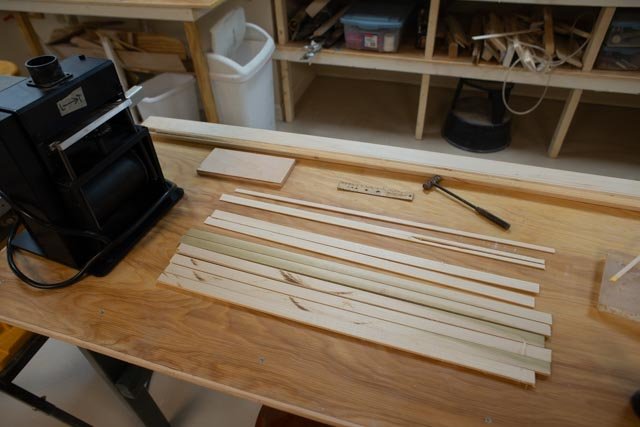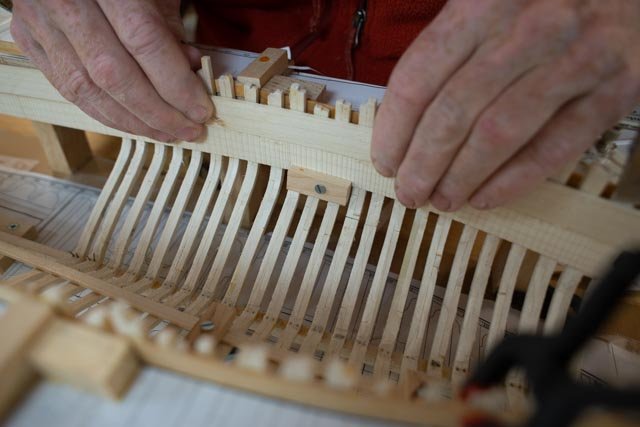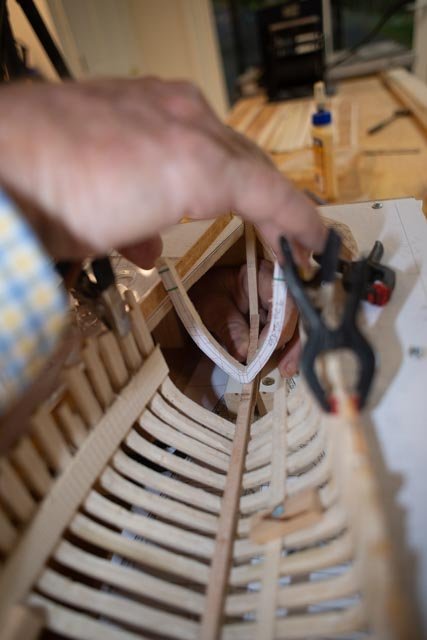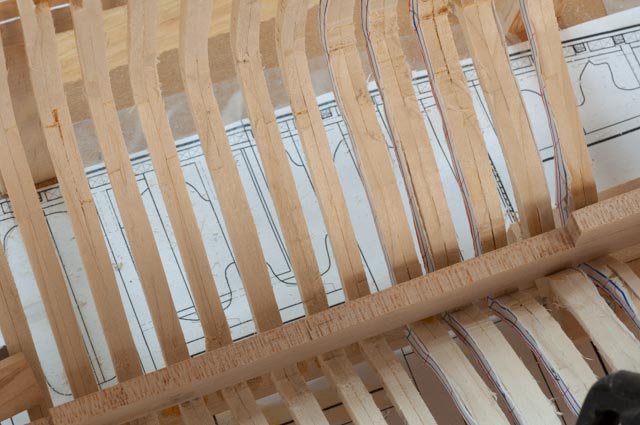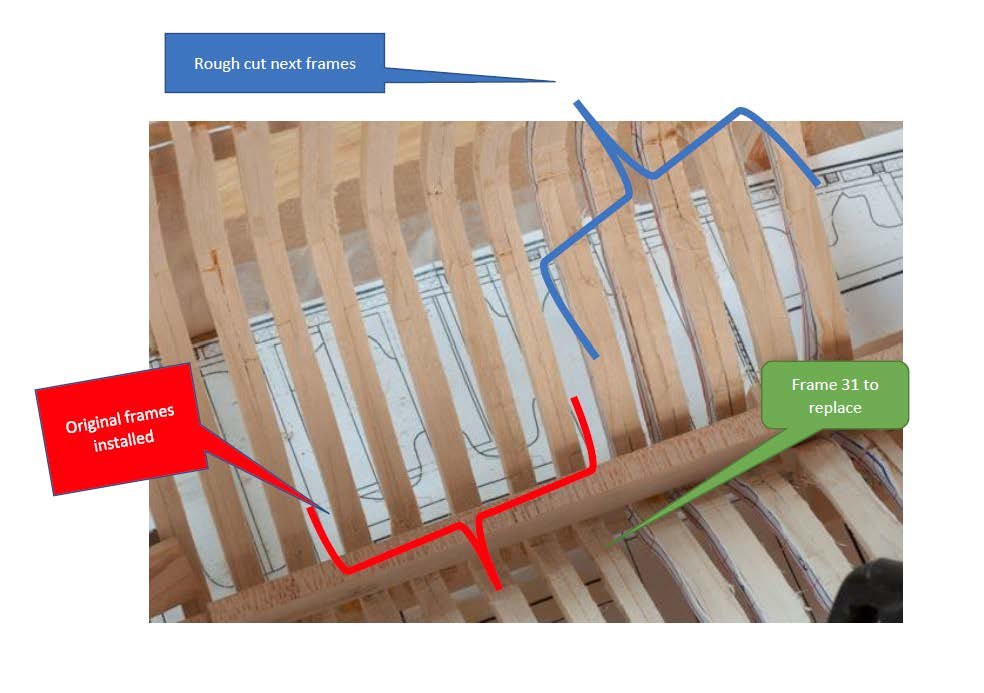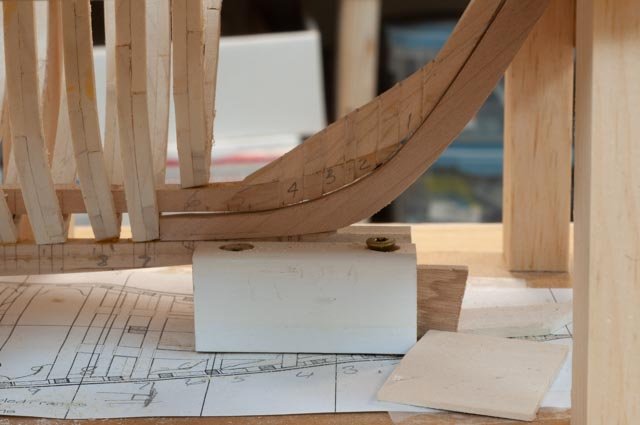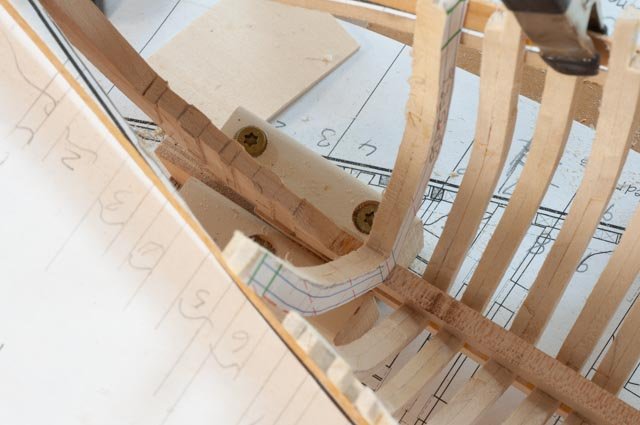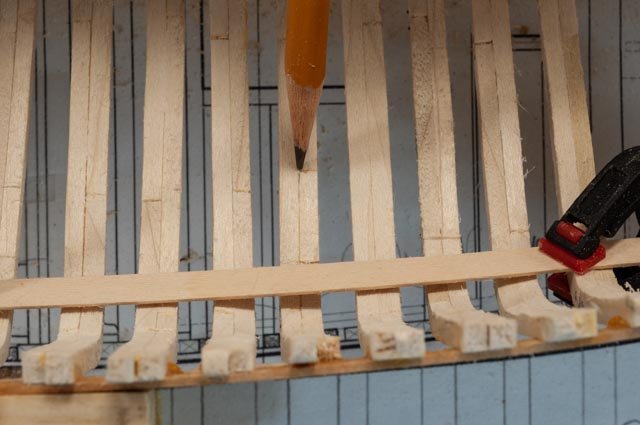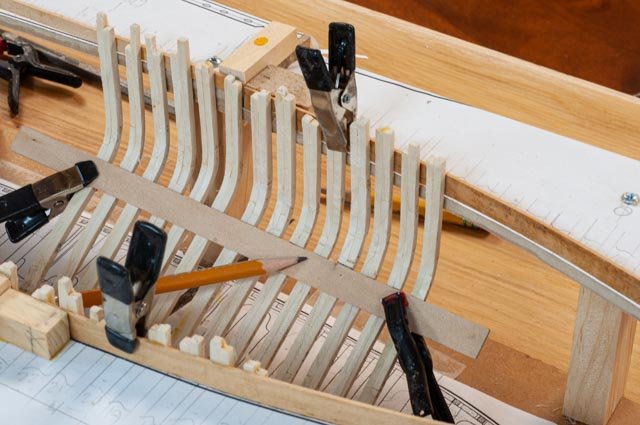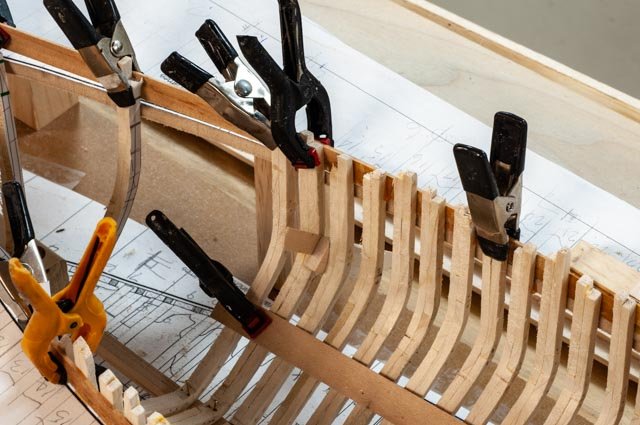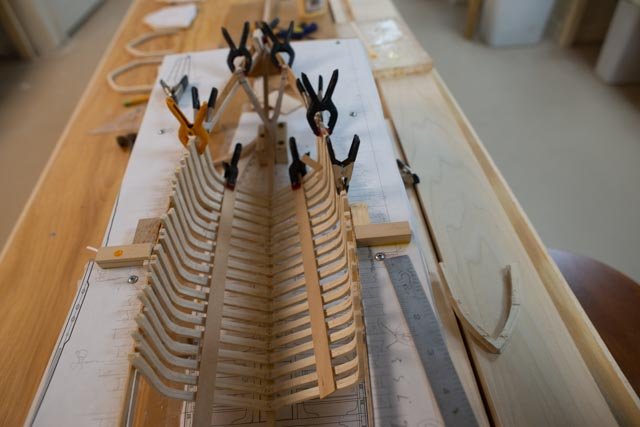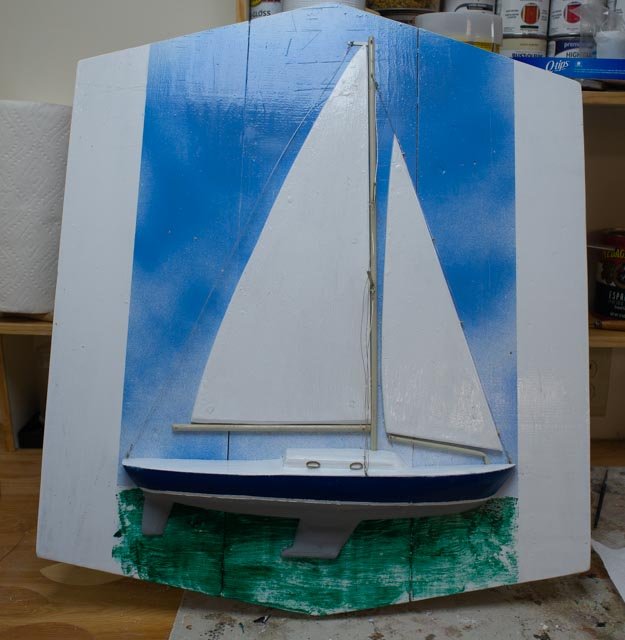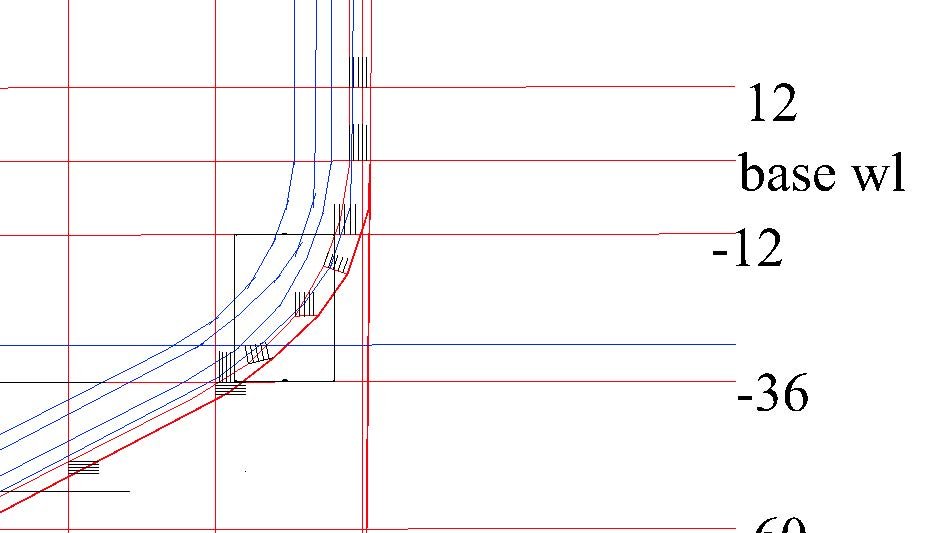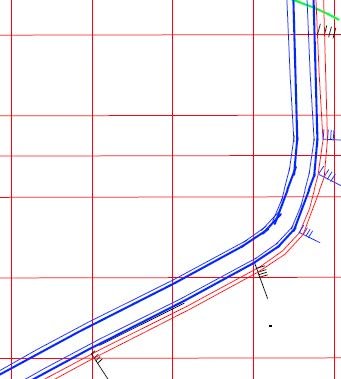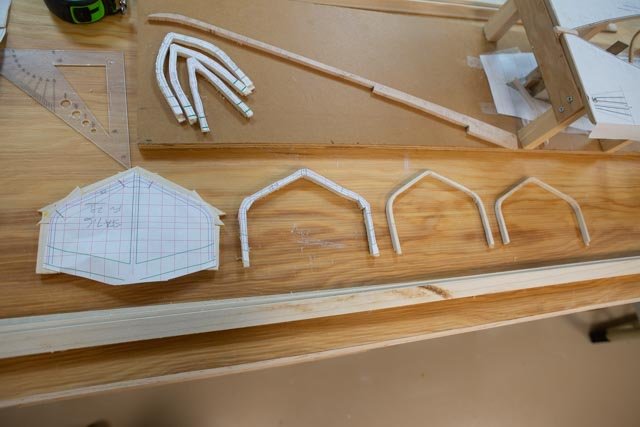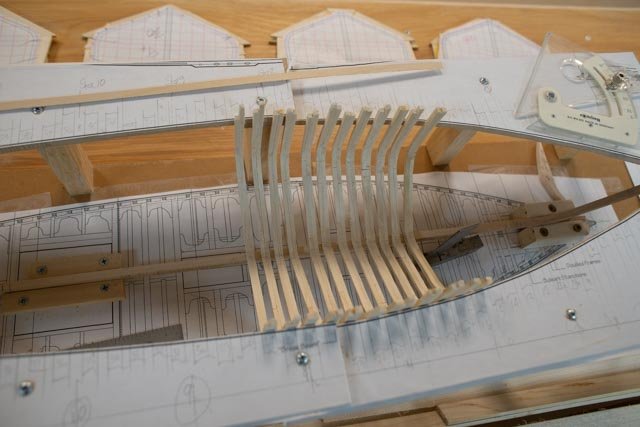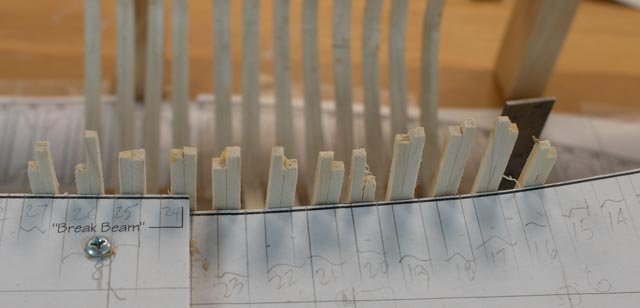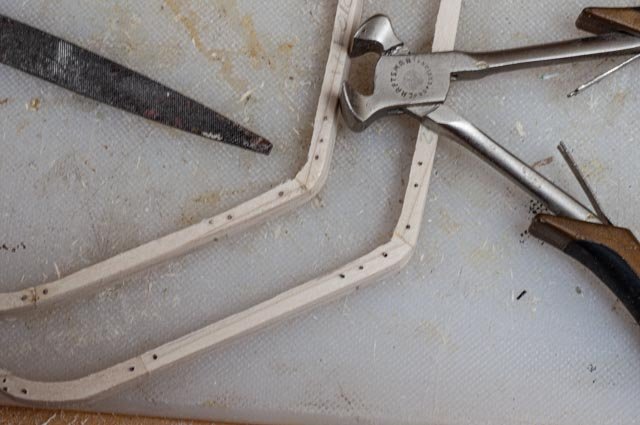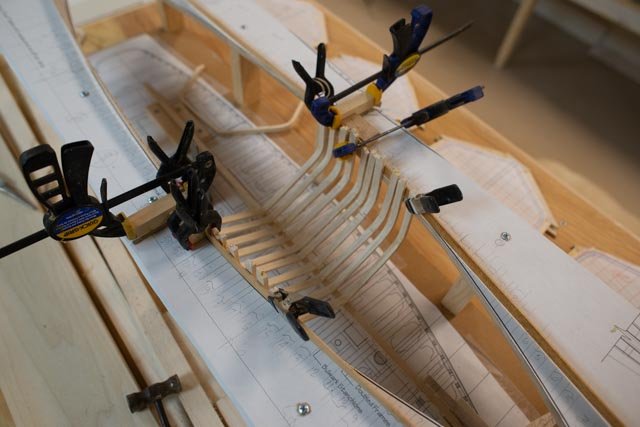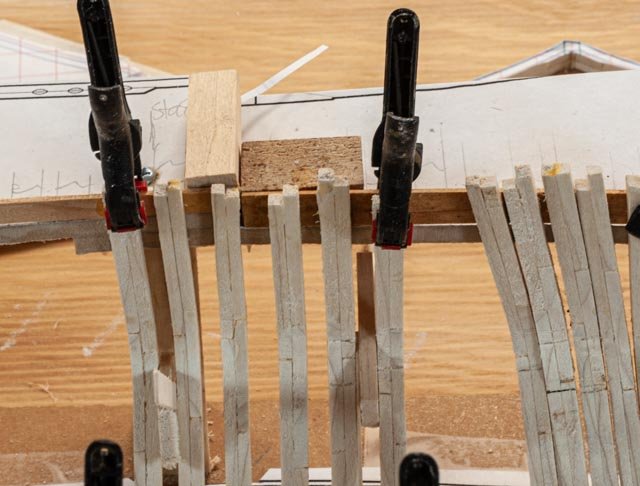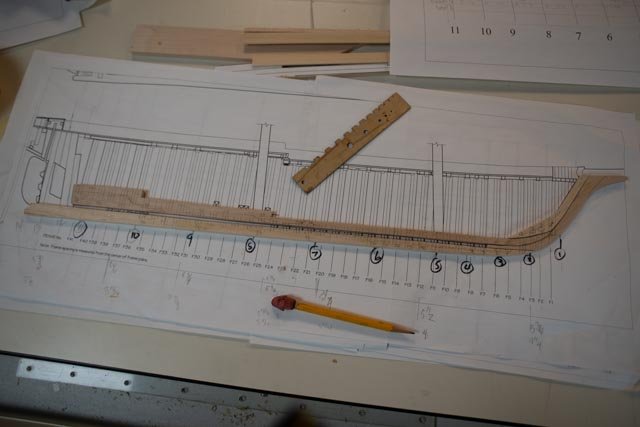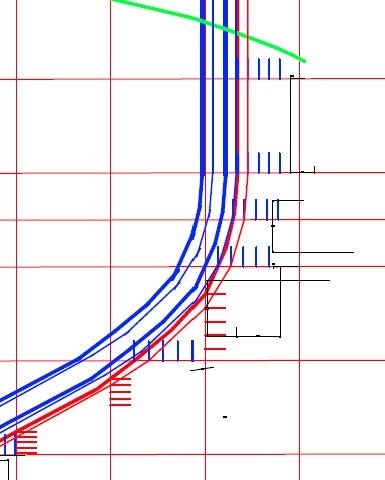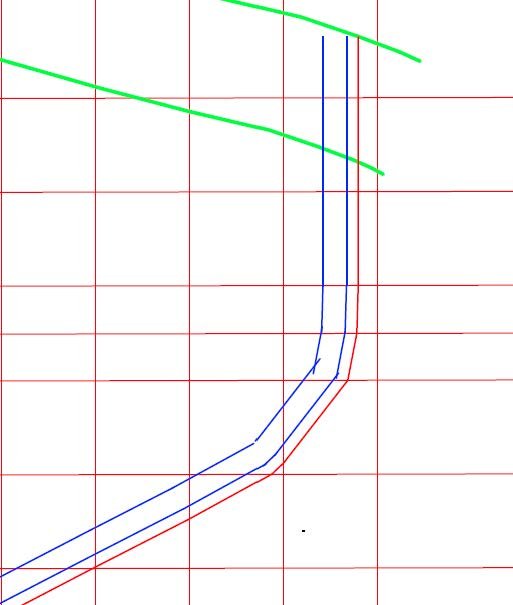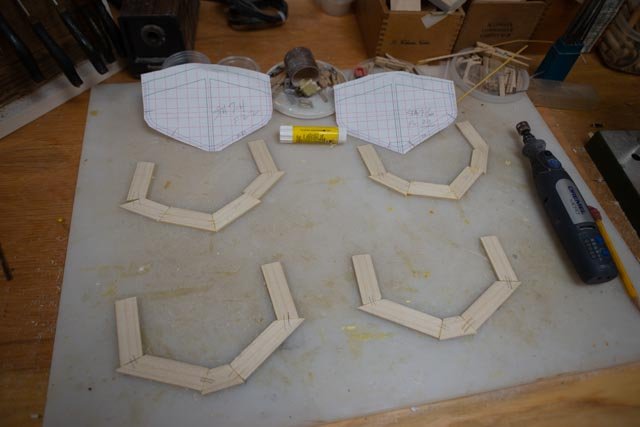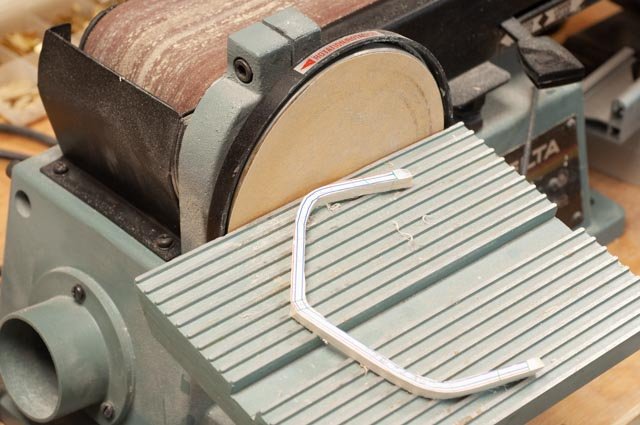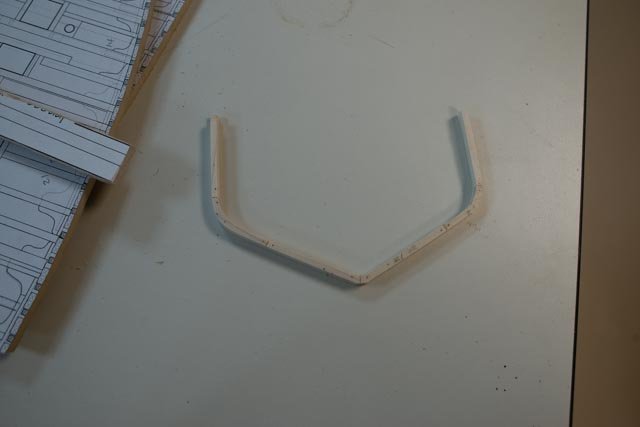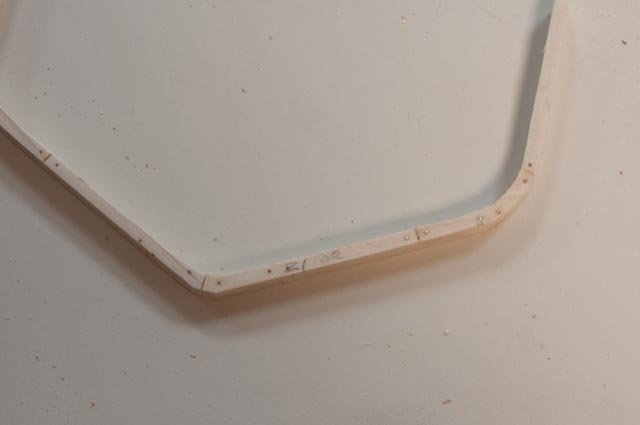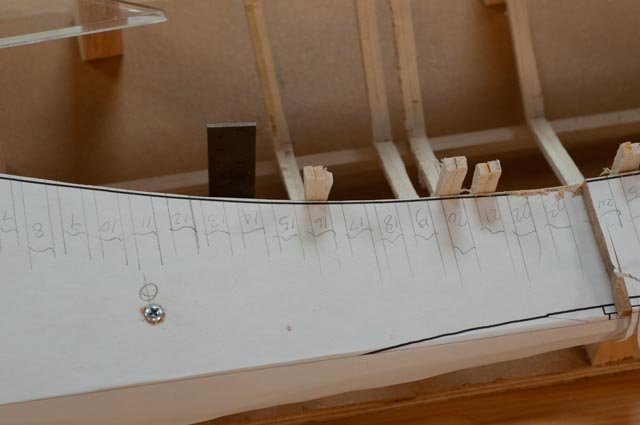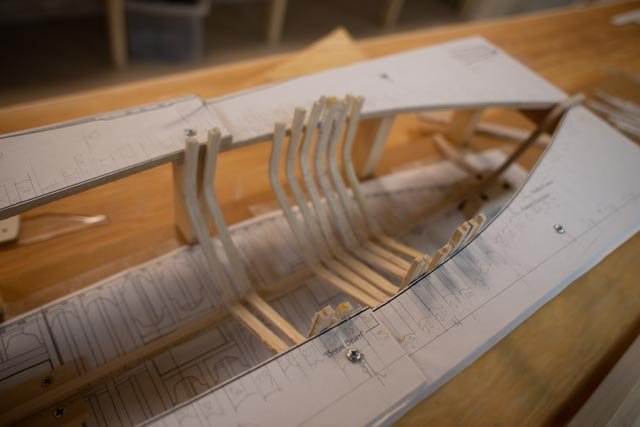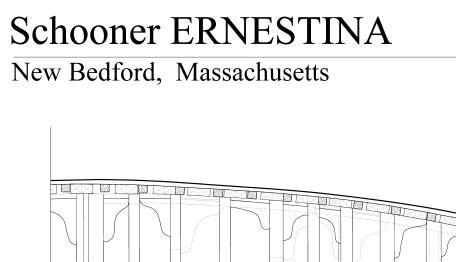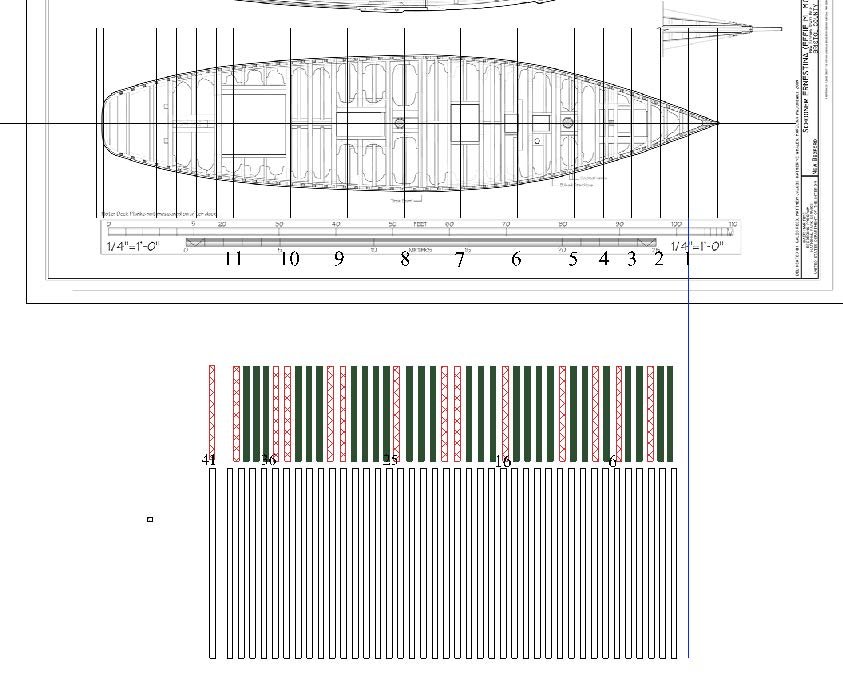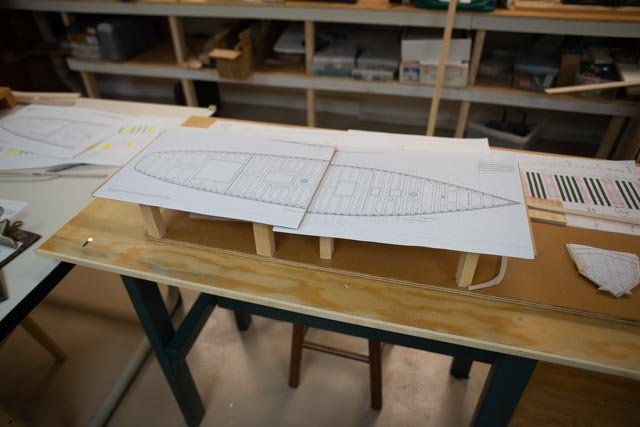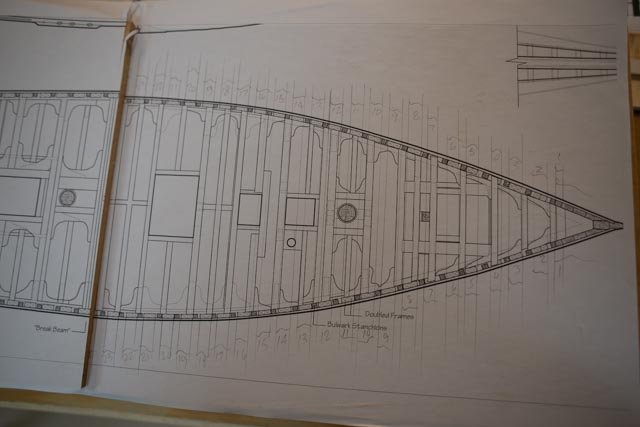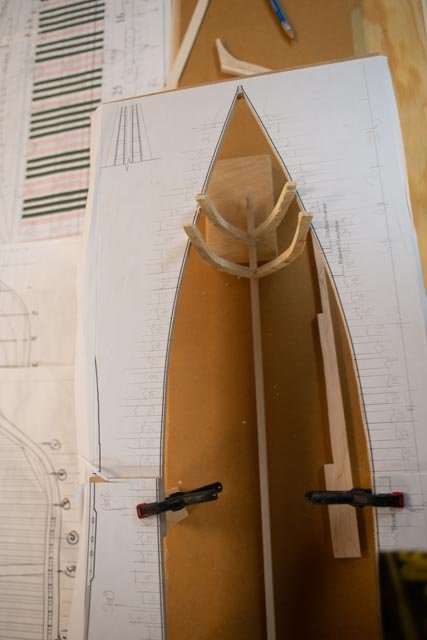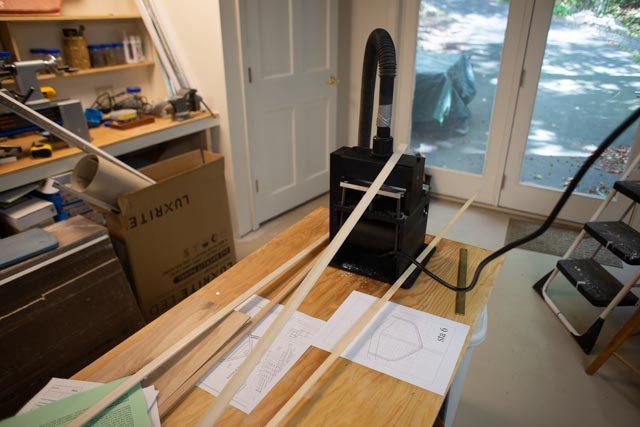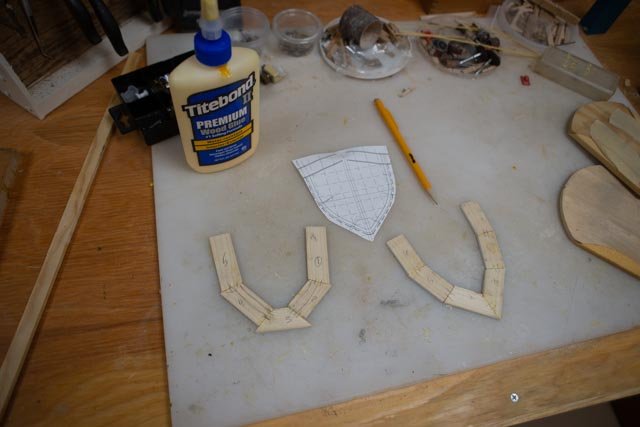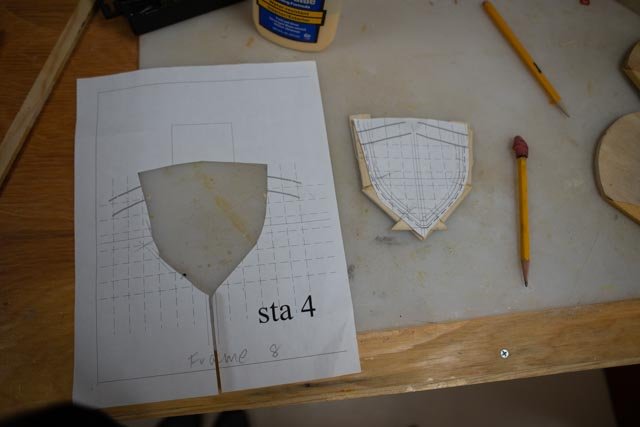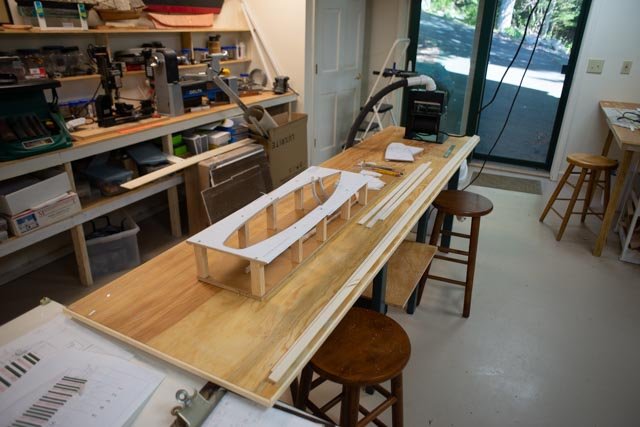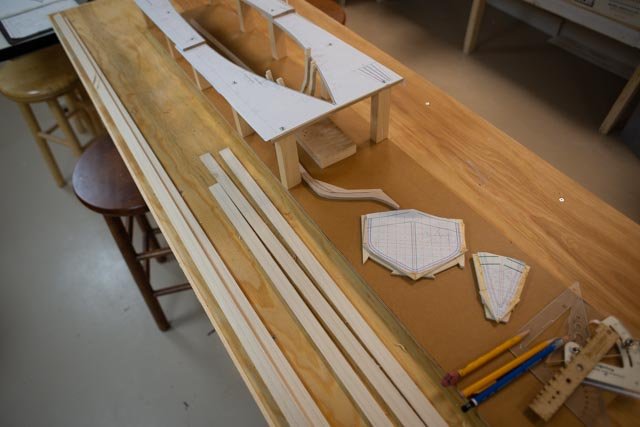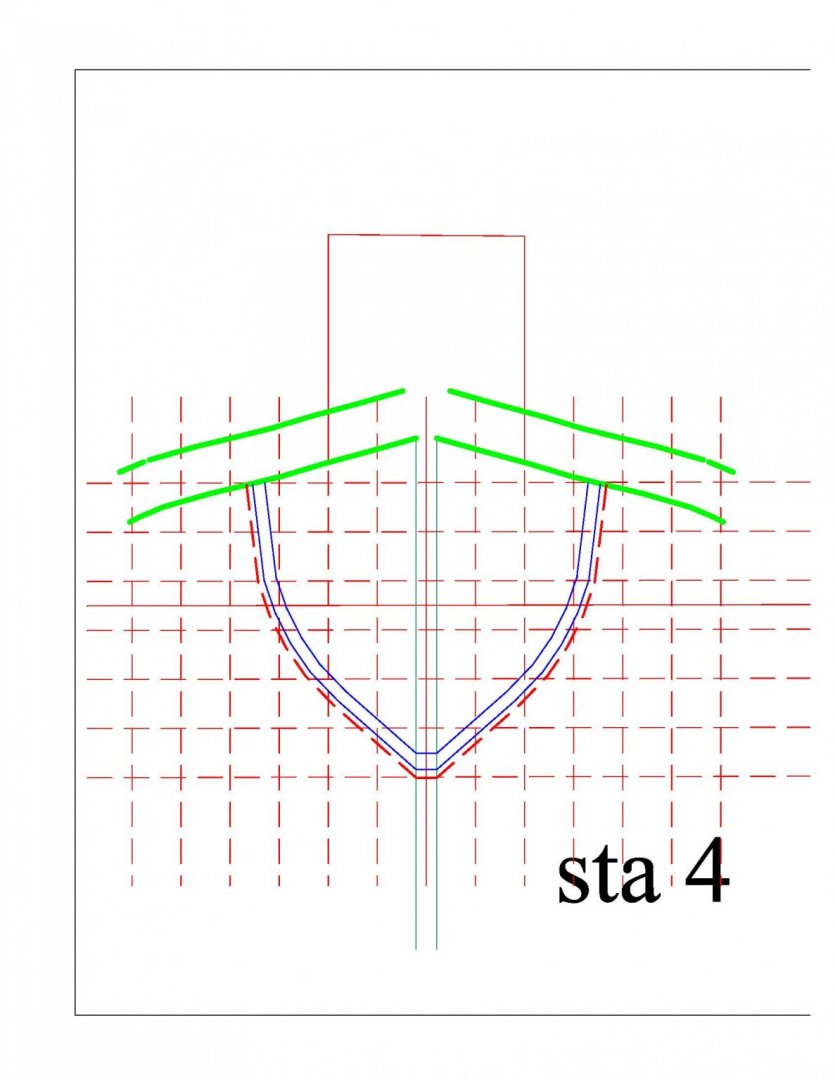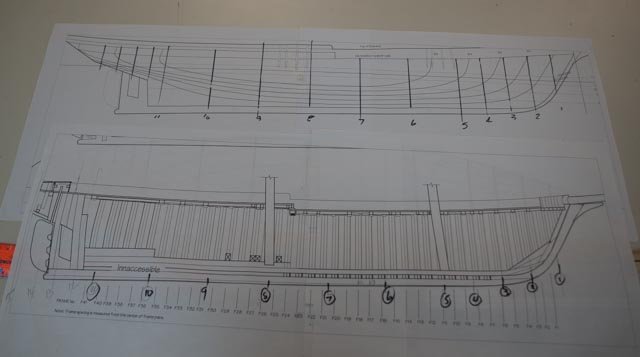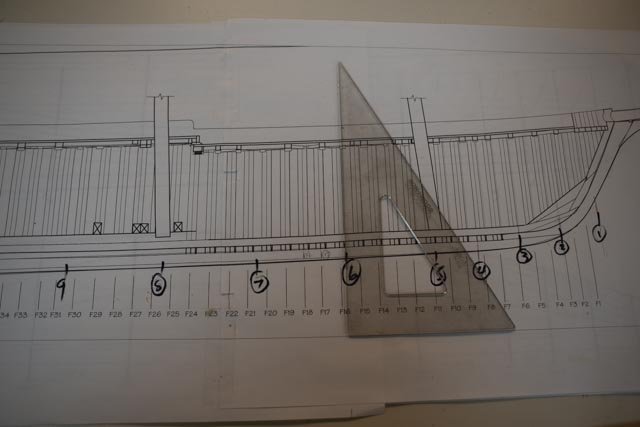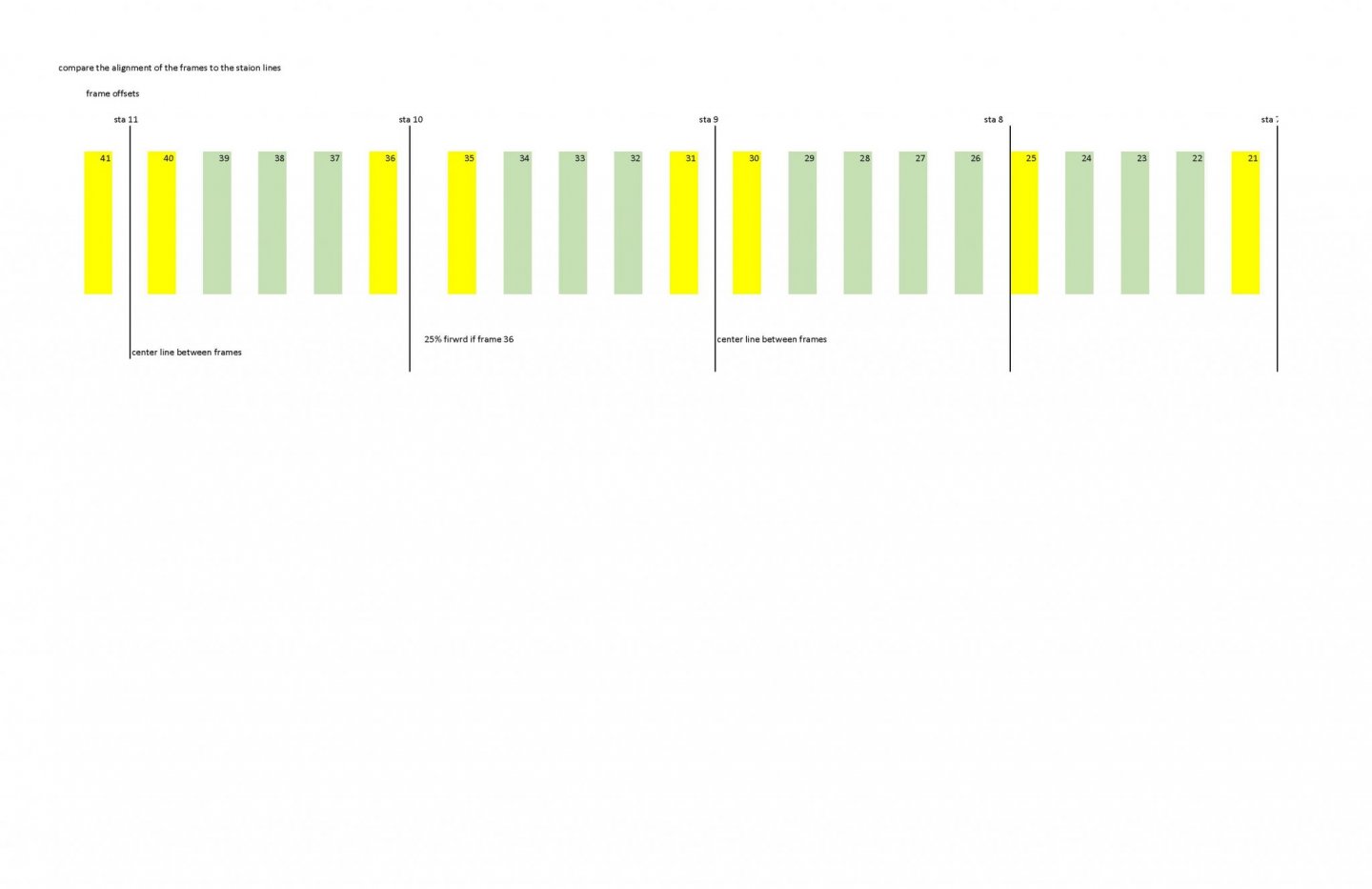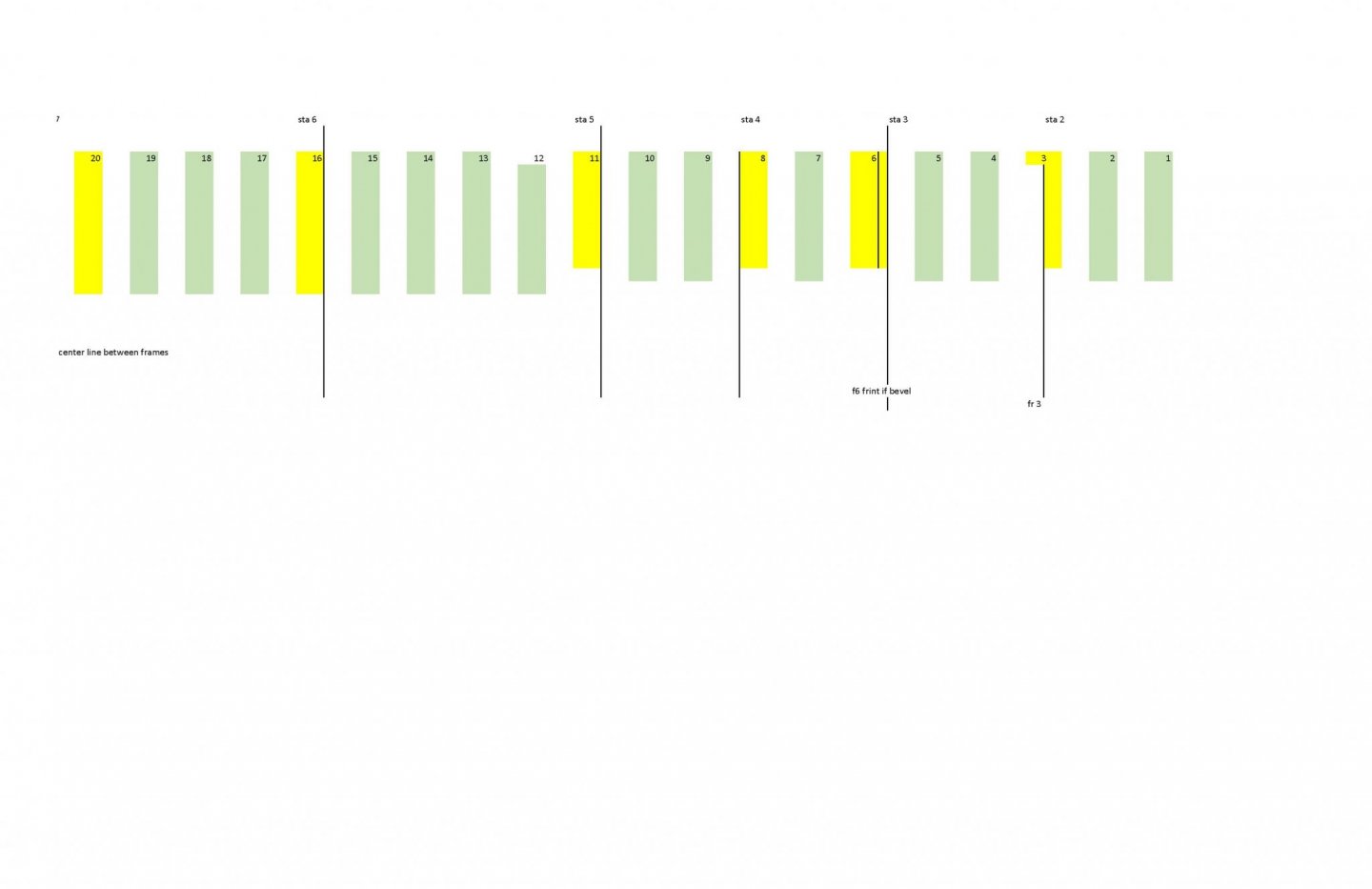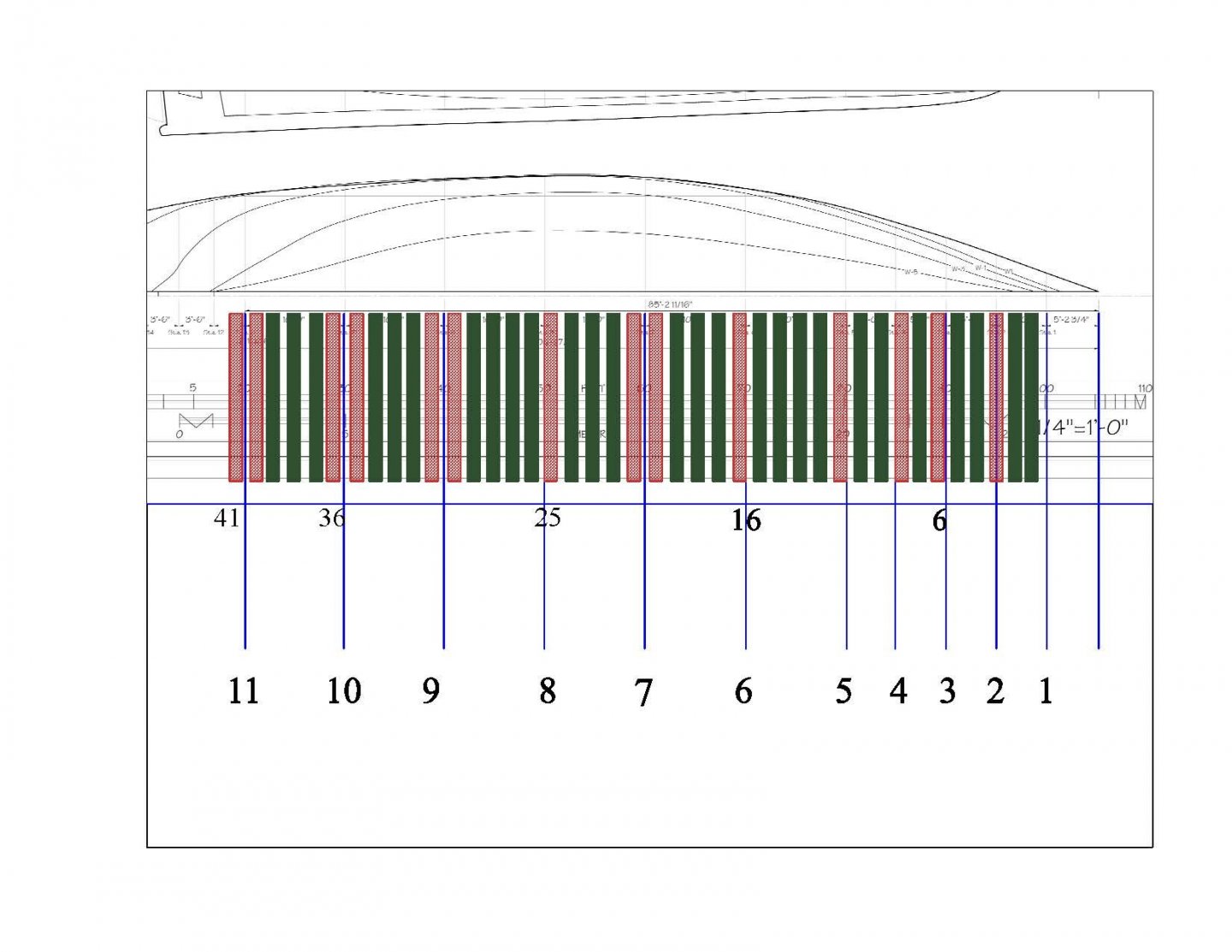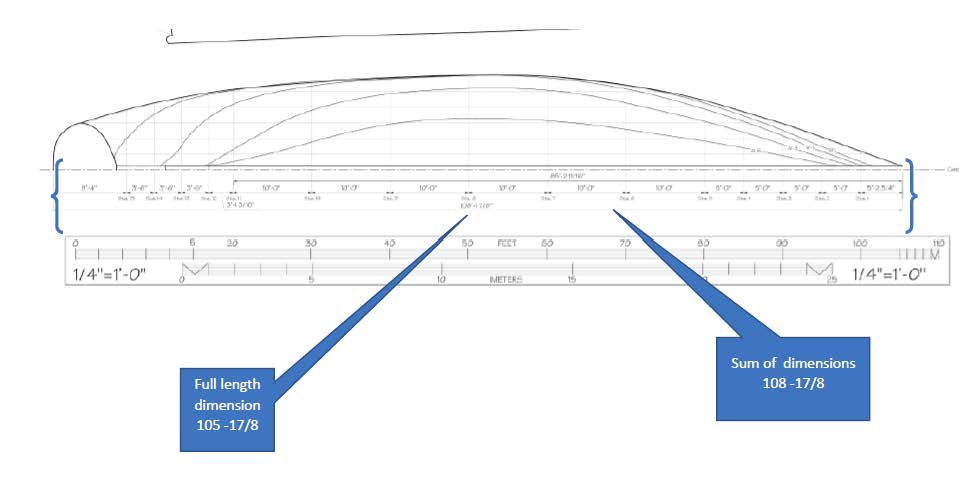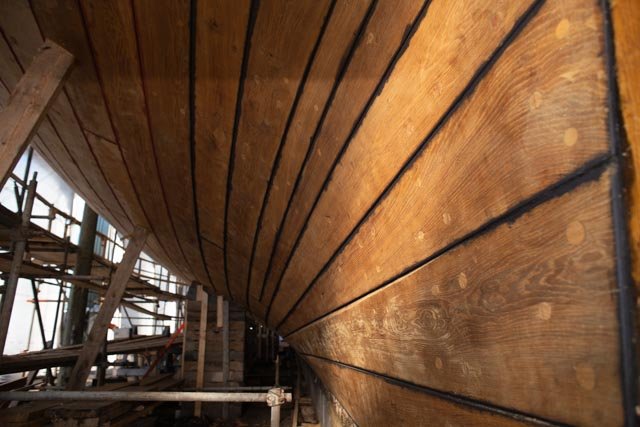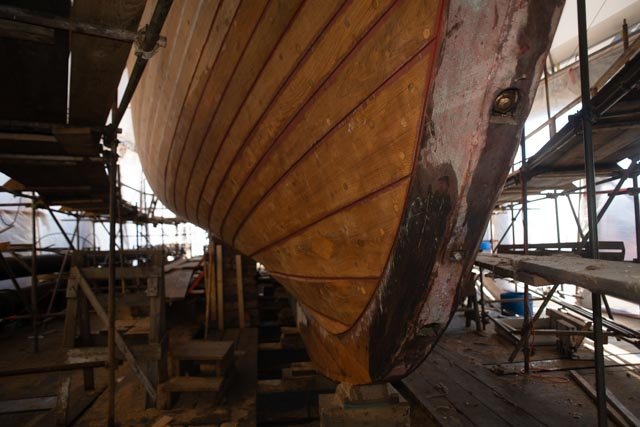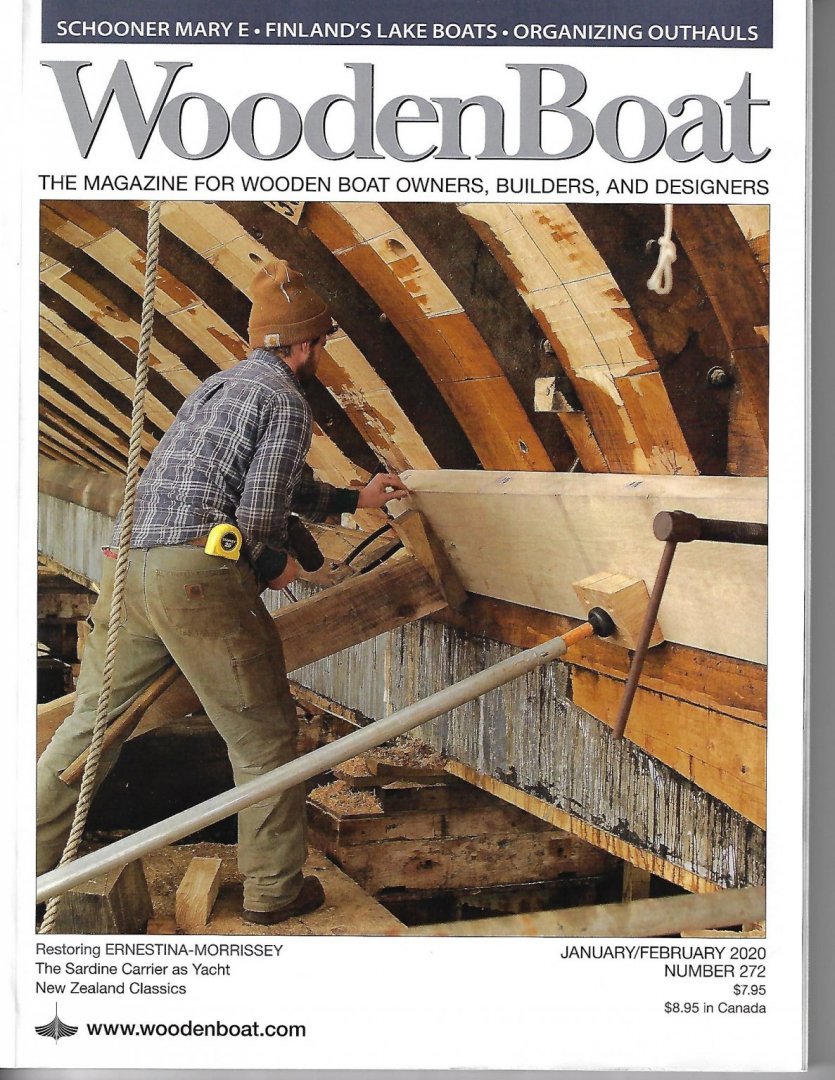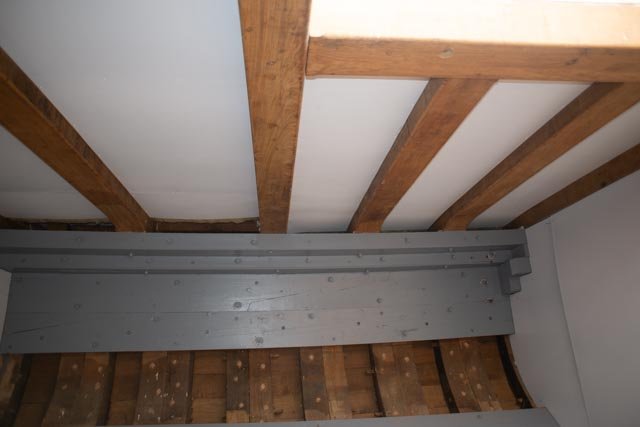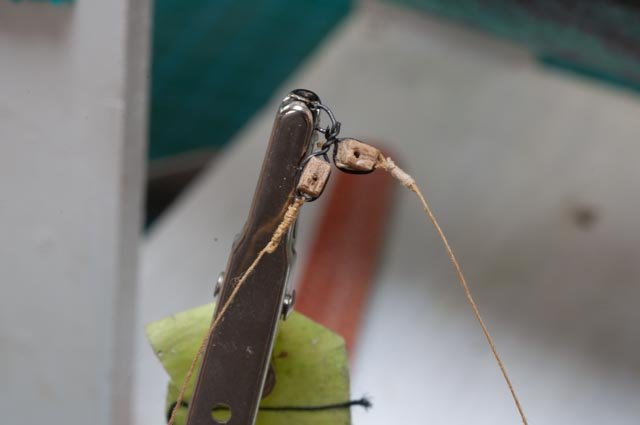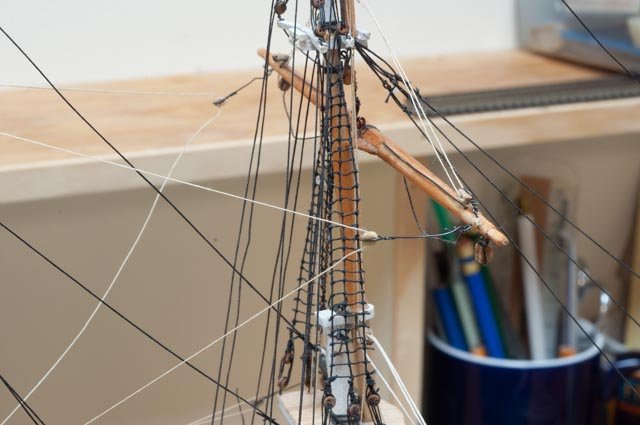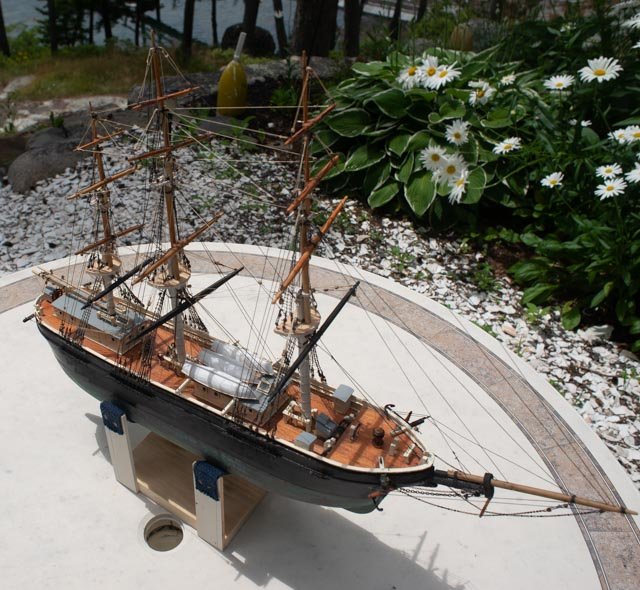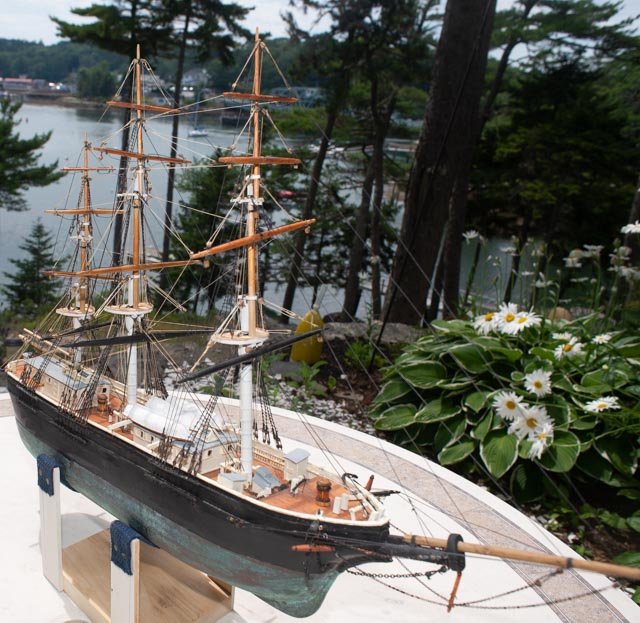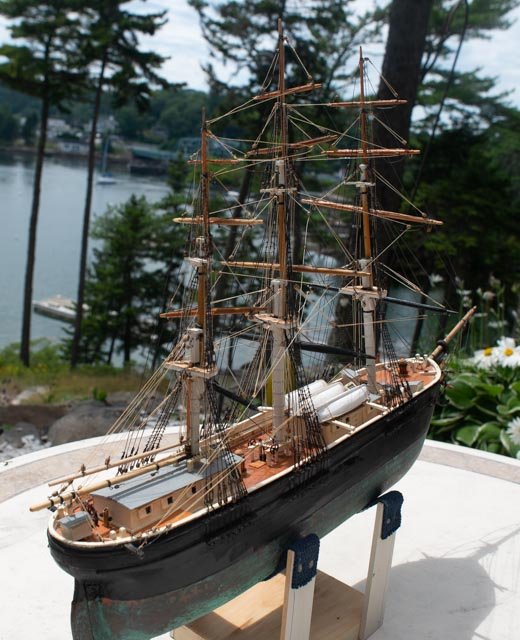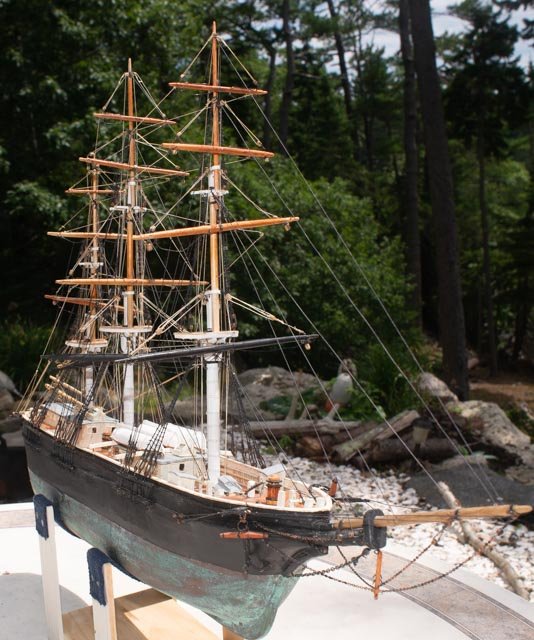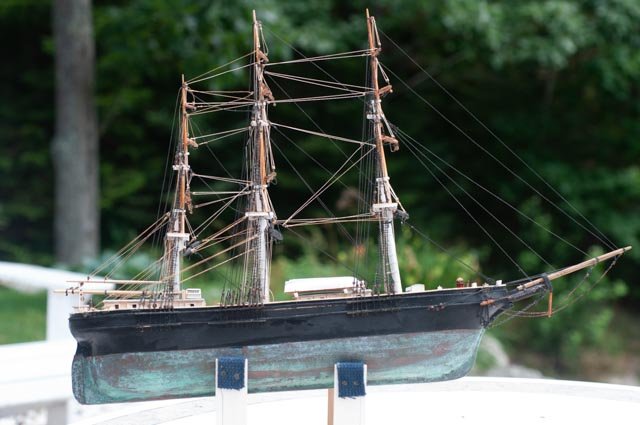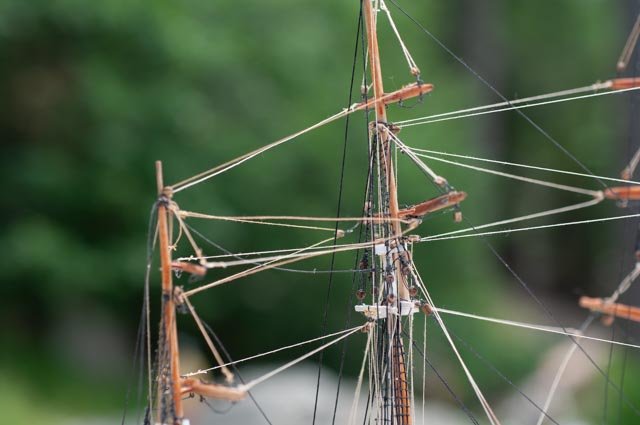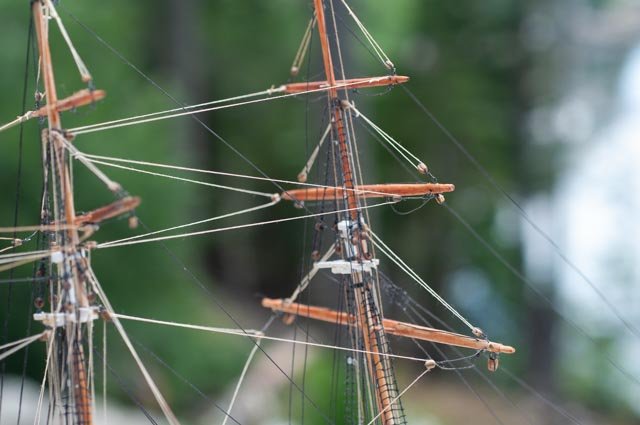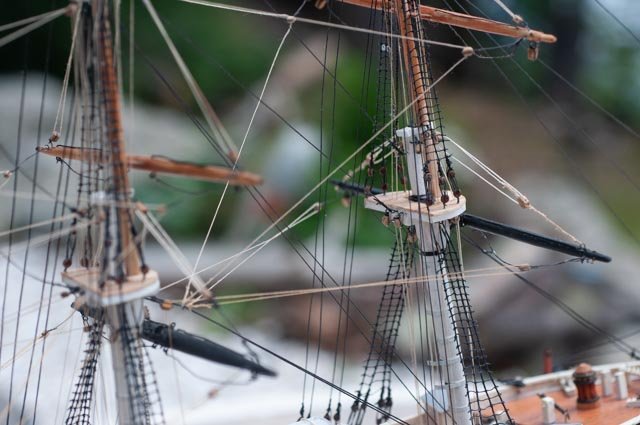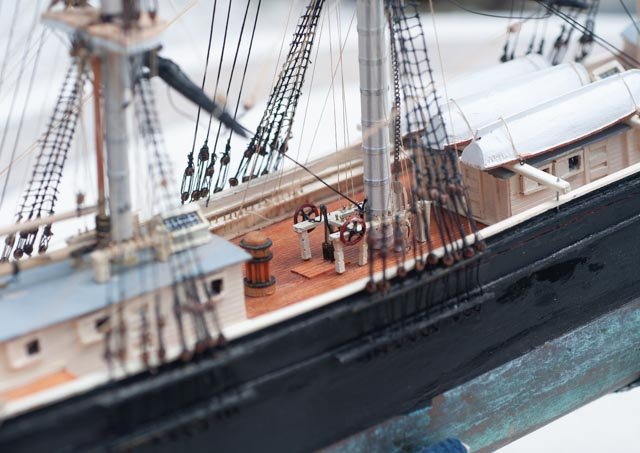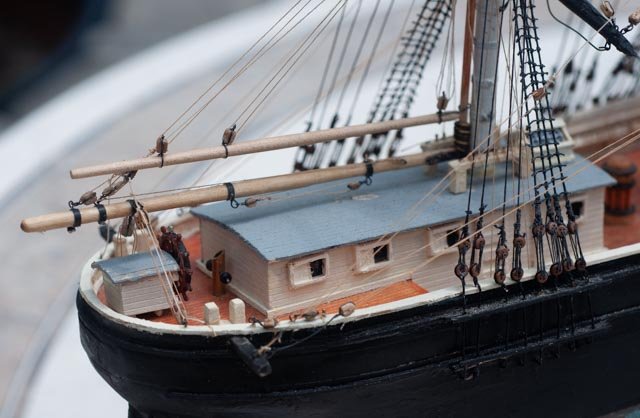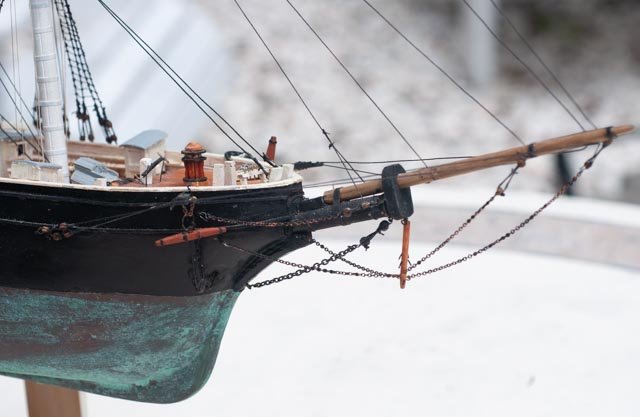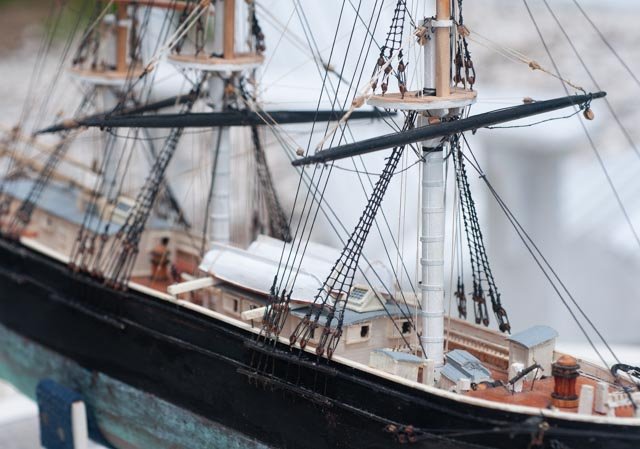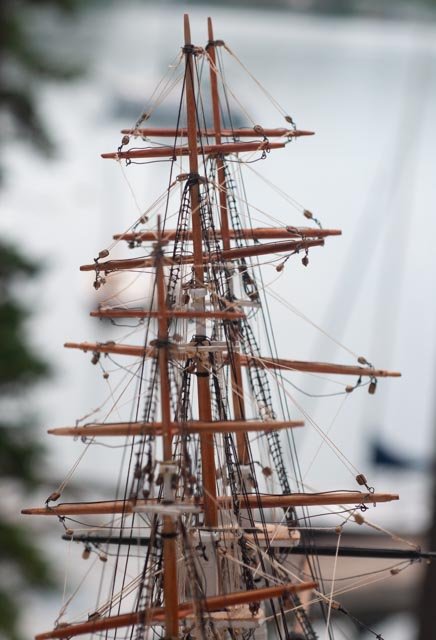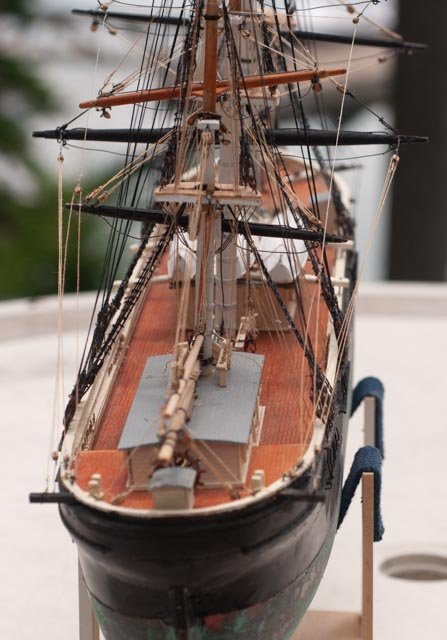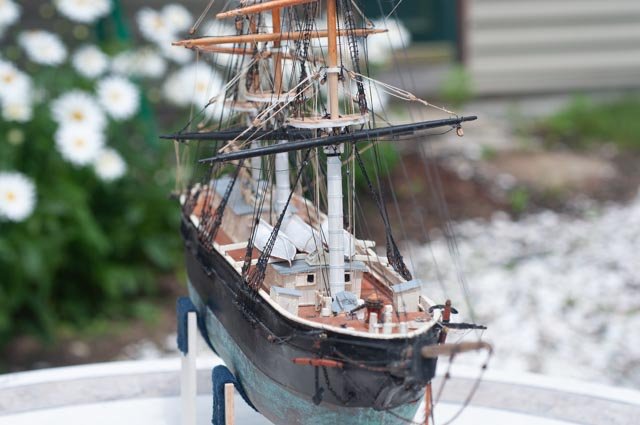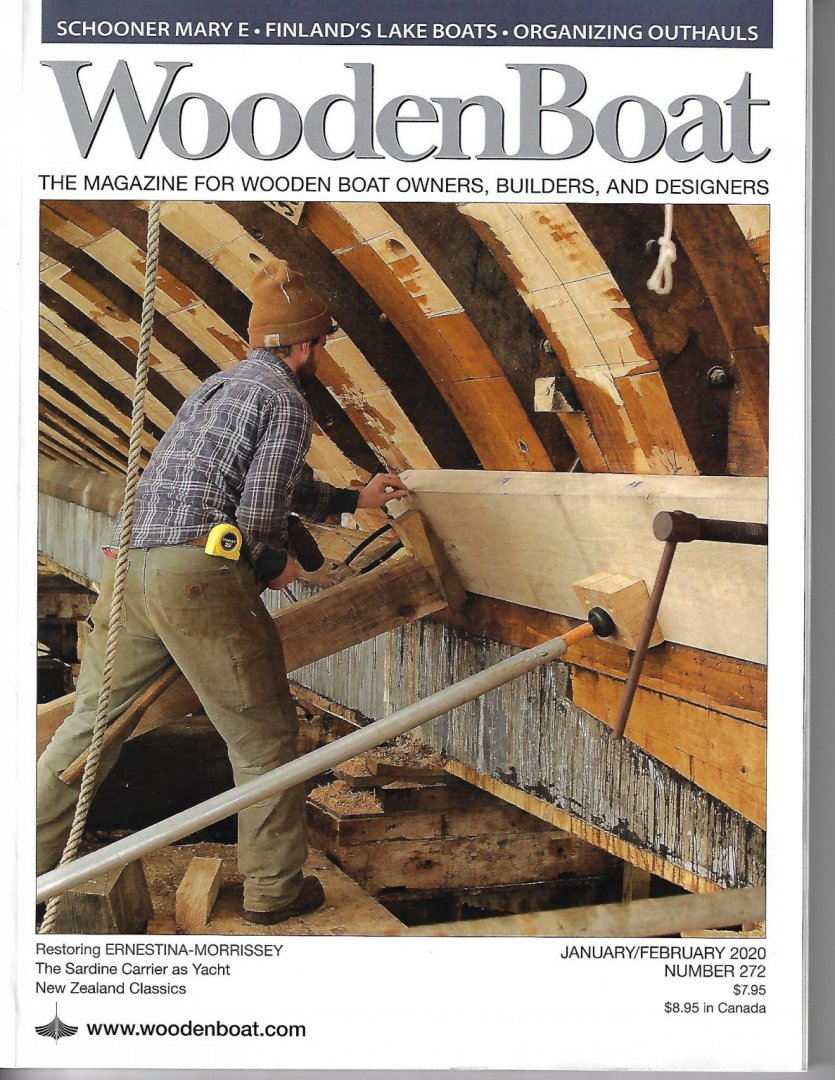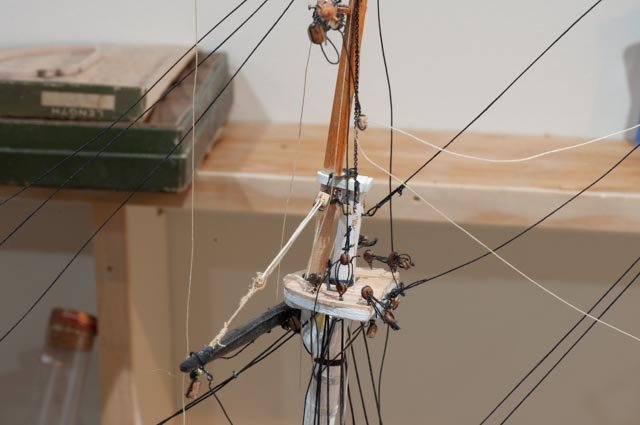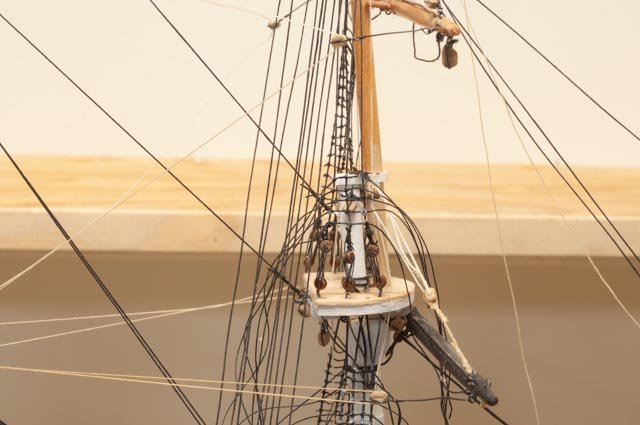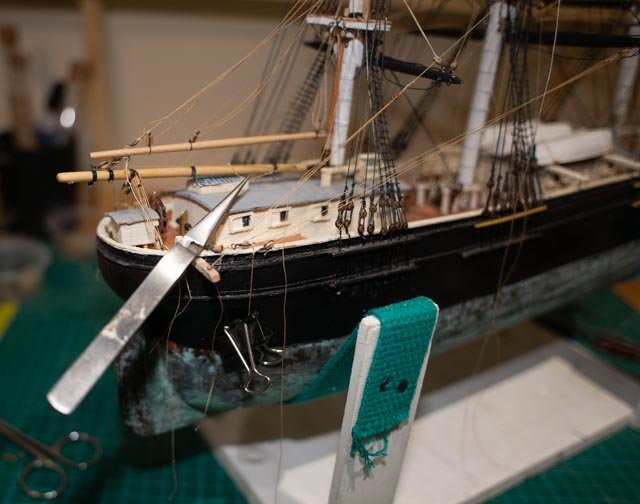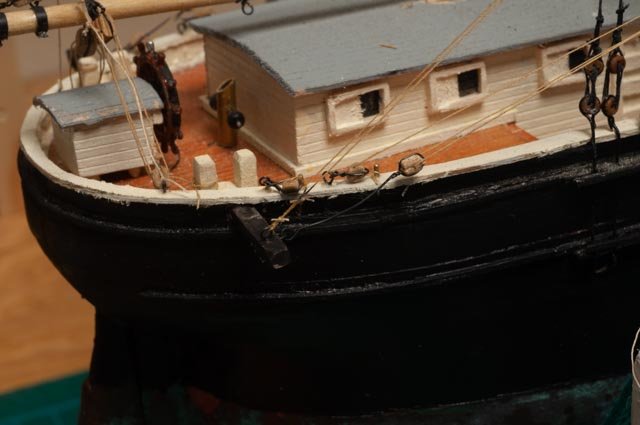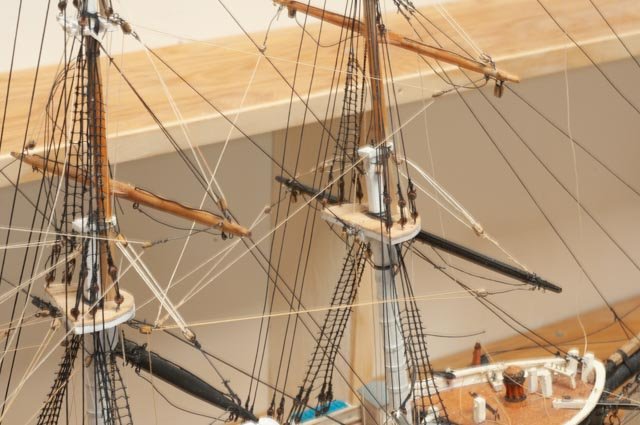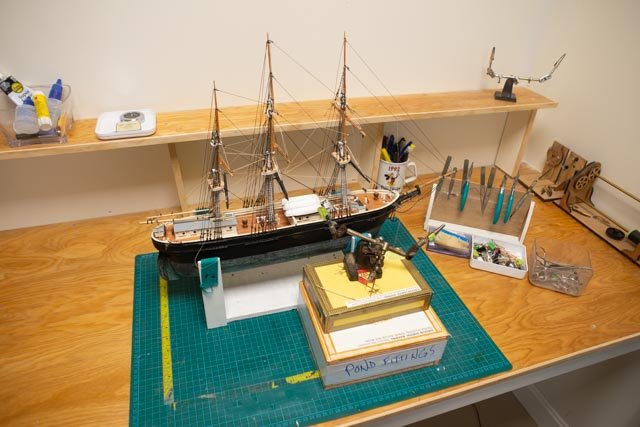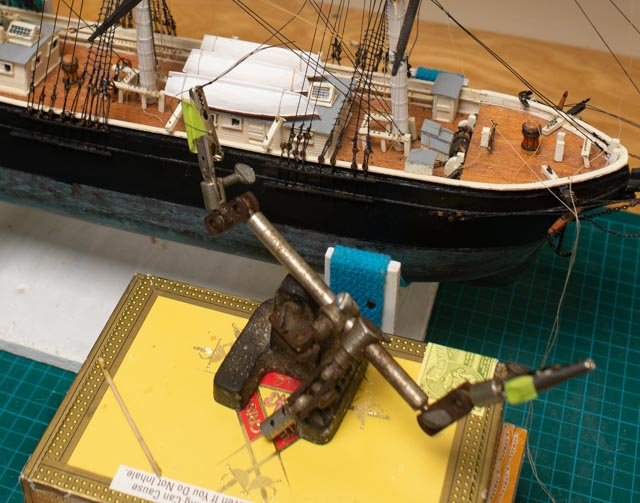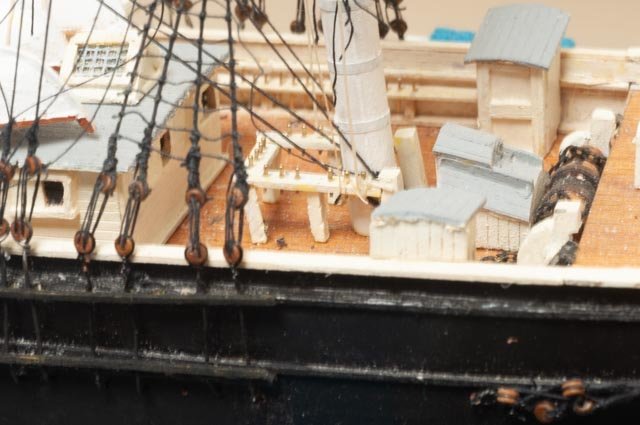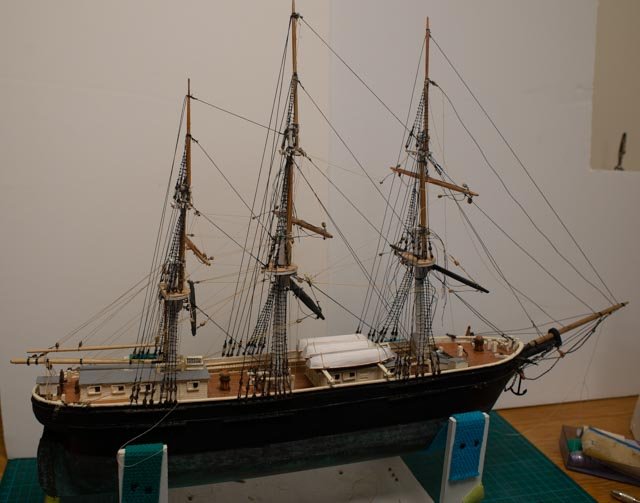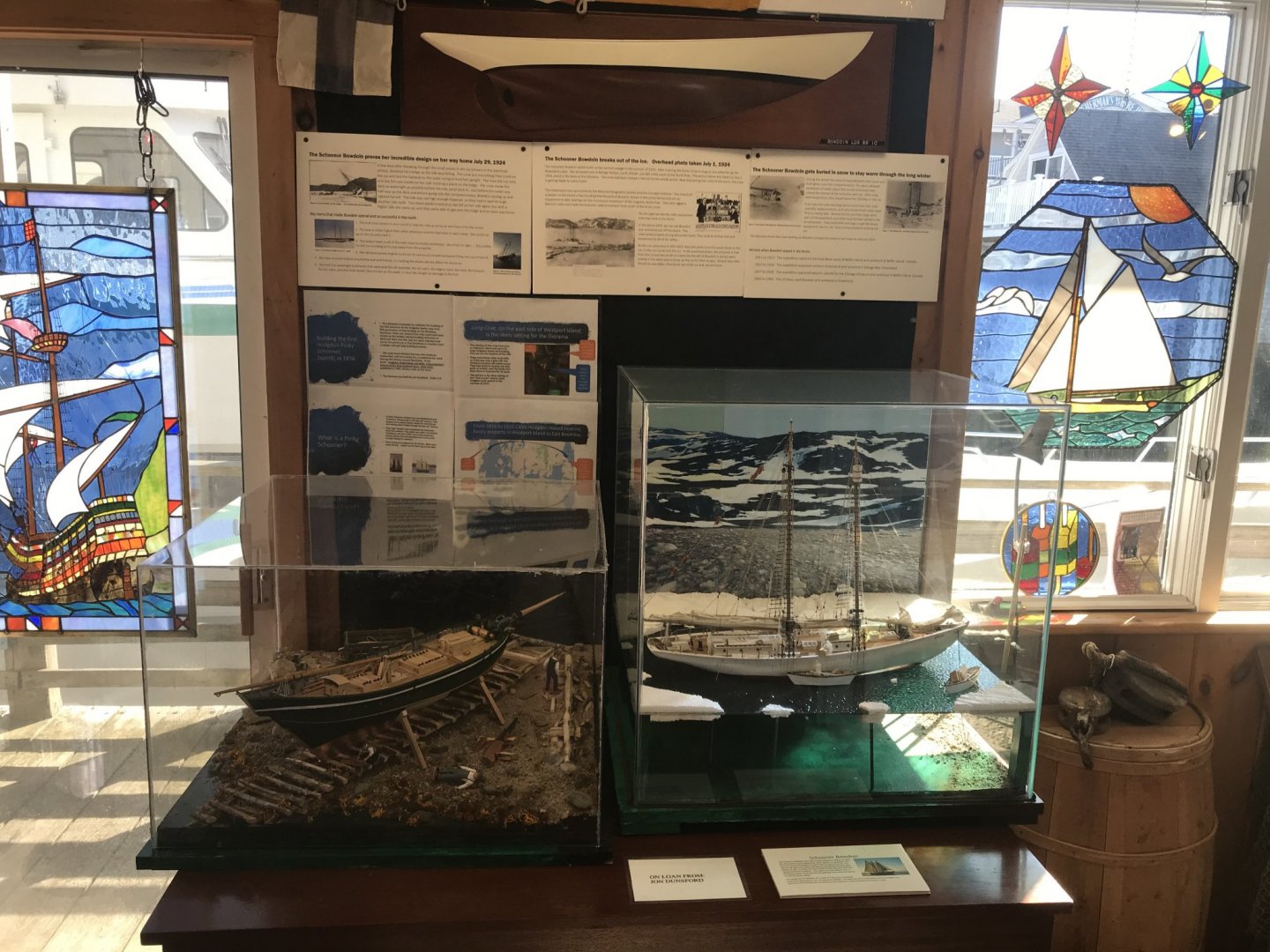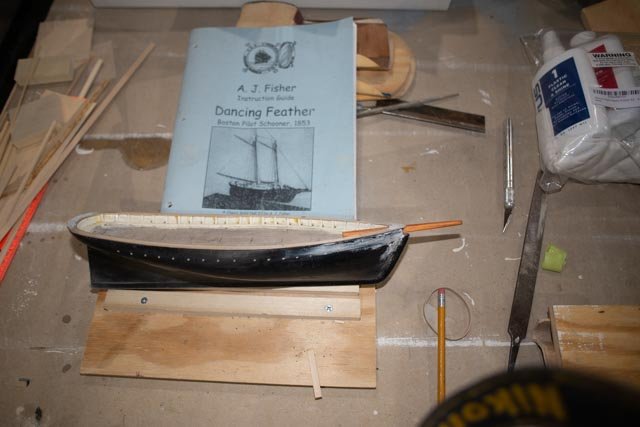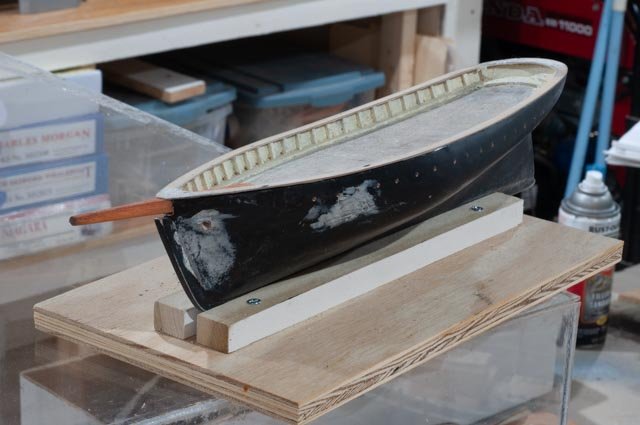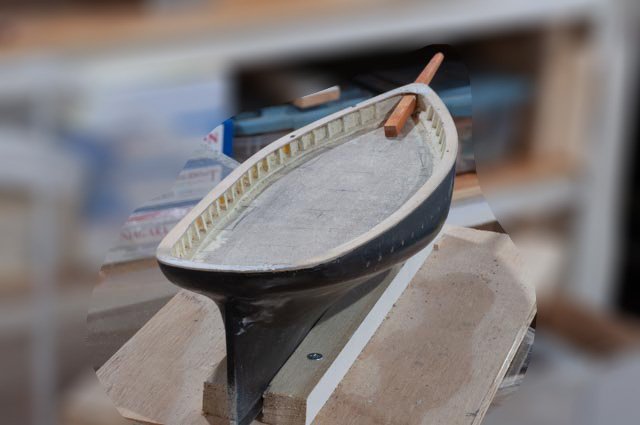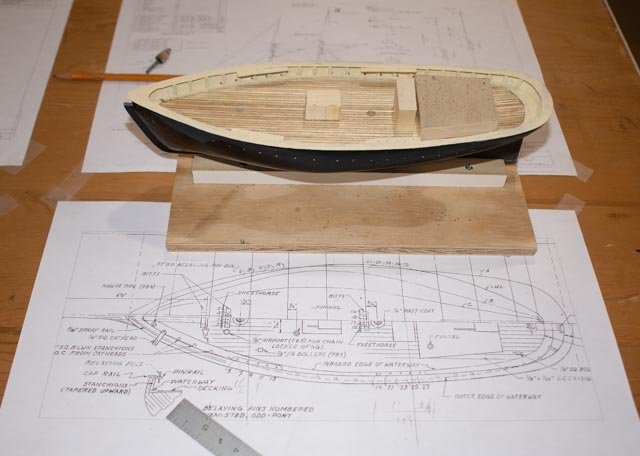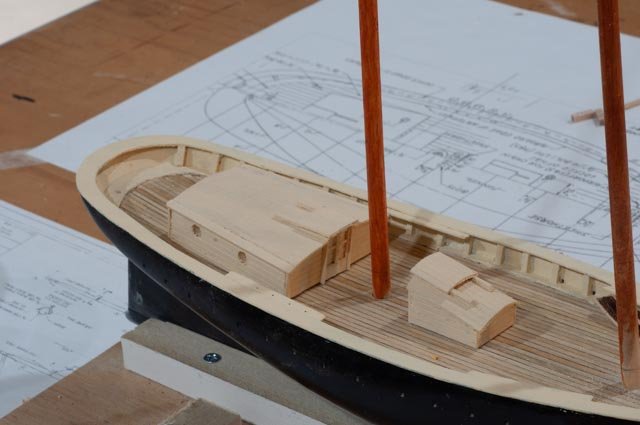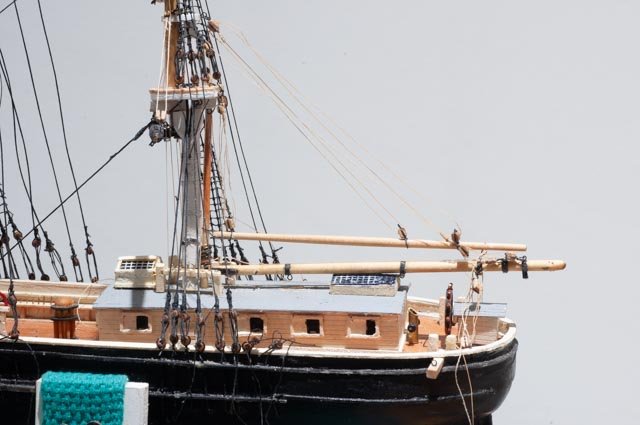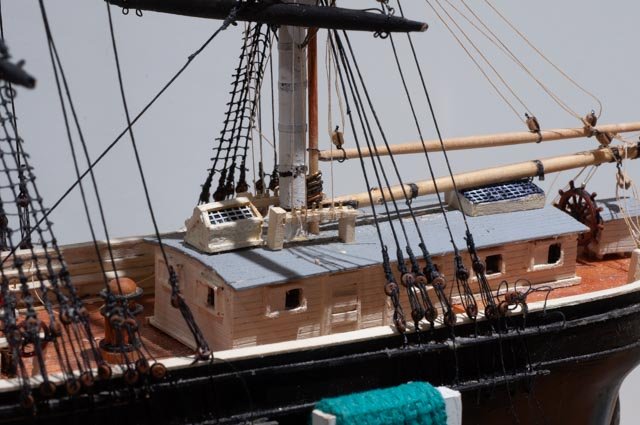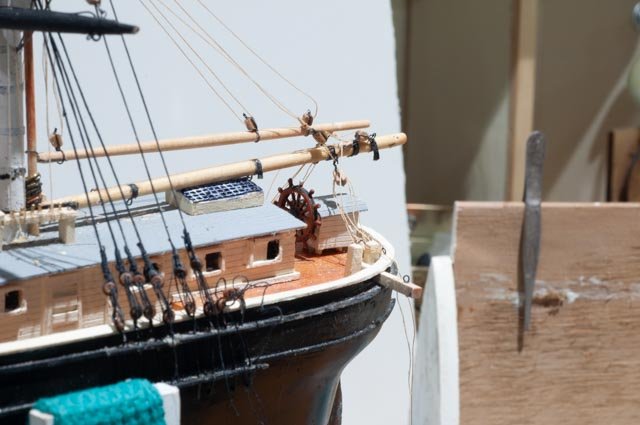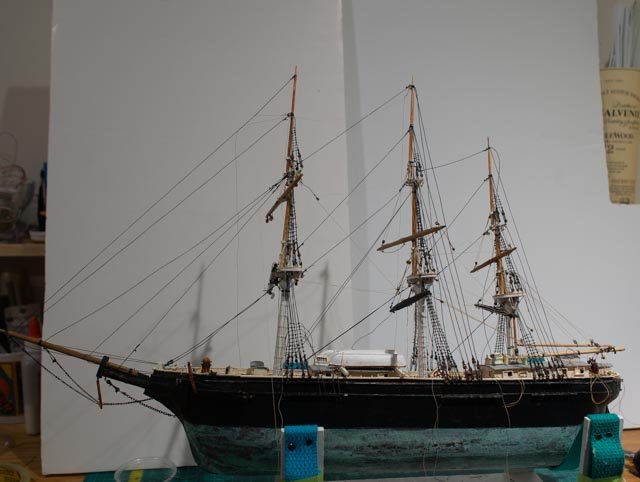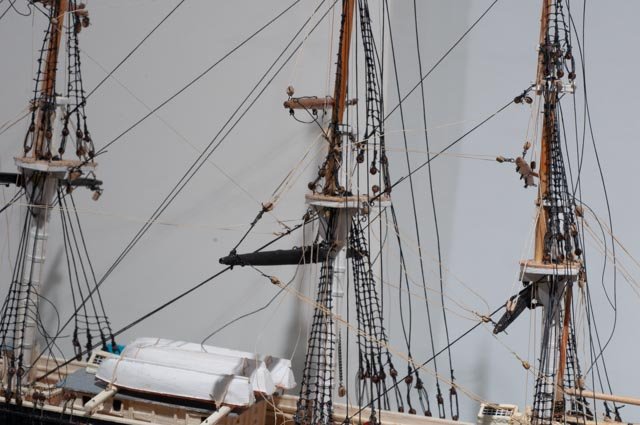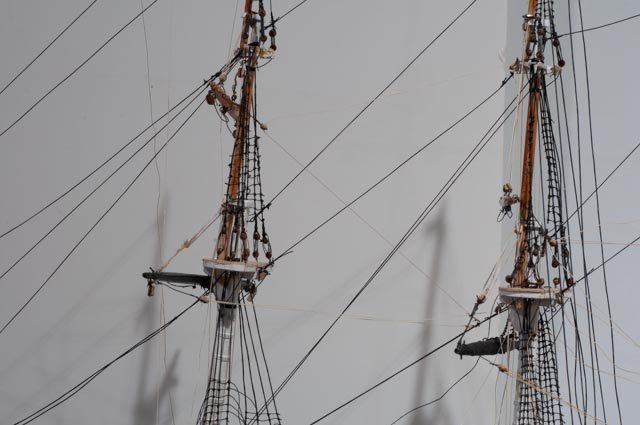-
Posts
852 -
Joined
-
Last visited
Content Type
Profiles
Forums
Gallery
Events
Everything posted by Jond
-
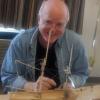
Ernestina Morrissey by Jond - FINISHED - 1:48
Jond replied to Jond's topic in - Build logs for subjects built 1851 - 1900
Post 12 Figure out the ends ..almost Before moving to the staining and painting I needed to at least figure out both ends. I think I am almost there The bow 119 I have reset all the frames. There is enough material for Mr. sandpaper to fix us up when we get out of the jig. 120 looking down at the deck. How best do is how the forward lazarette. 121 looking down through the forward lazarette we see several interesting details. The dark colored frame the medium dark cherry colored hook, the concrete and the inside of the golden oak planking. Something to think about The stern 122 I rebuilt the dead wood assembly more like the photo. 123 here from the side. 124 I reset the frames 42-44. 125 here from the side we see we are getting a better fit. 126 from the end we see what we have yet to figure out. How to build the transom. Ross told me there is a frame in the shape of the transom that creates the flat portion. Now I need to figure out how to make that shape considering the limited drawing information. I think a little trigonometry is required 127 here I am taking the major deck frames that let me tie together the deck shelves with eh dead wood structure. 128 here I have dry fit the shelves and the beams This was the point I realized I had to stop building until I sorted painting and staining. Next up I will stain and paint for a while and then install these components to complete the basic alignment. I will then solve the transom, bow hook and other internal frame members before starting the decks All for now -
Larry i am so glad you posted this update. I got to go through your log and enjoy your experience and applaud the results. I too love our Maine coast and the history of Schooners. Several three masters were built here in Boothbay and I know I will build one one of these days. your model and the case are really inspiring. Thanks for sharing Jon
- 43 replies
-

Ernestina Morrissey by Jond - FINISHED - 1:48
Jond replied to Jond's topic in - Build logs for subjects built 1851 - 1900
Post 11 What color is right I have progressed with the rebuild of the stern, but before I take this log there, I came to another big issue. It involves the process to determine what I am trying to model and therefore what color should the components be. I realized before I carried on with gluing in the frame that it will be exceedingly difficult to color parts after assembly and I need to consider what to do before installing. First question is what am I building 1. If I am going to build a schooner ready to launch, I need not worry about the innards. In fact, I can relax when I get to planking because putty and paint are friends. However if that is what I am doing, why did I not just build the hull with bulkheads. I would be on deck by now. This version is out 2. If I am going to build a masterpiece of art representing the structure, I should have used box wood or swiss pear and walnut and plan on Alaskan yellow cedar etc and perhaps tung oil if not wax. Anyone who has seen my work knows that is not in my wheelhouse, so this version is out. I am about trying to make it right, she will unfortunately not become a masterpiece but hopefully a learning tool as we try to record what we can of the history of Maine shipbuilding. 3. If I am going to build a diorama showing some stage of the work, there are many decisions. As of now, and considering my recent builds, I am leaning in that direction. the huge 120 x 40 foot car on the railway is something in itself. much to ponder but that is what winter is for, Therefore, as a partial built craft, I need to take what photos I have and more if needed to understand what is the wood, and what was its color as milled and fastened, and then how has it been treated thus far and ultimately what will it get. To that end I have taken some photos and went to the site this week to review with Ross Branch what materials were used and got myself ready to choose. So here we go on what is there at an intermediate stage of construction where: The structure is affectively complete and coated if indeed to be coated. [ mid cabin posts are still natural]. The frame itself is oak with linseed oil combination that blackens, though some are clearly less affected . Some members of the structure are painted. The clamps shelves and stringers by example. The undercoat seems to be universally gray. The deck is Douglas fir and will be partially in place to see through to the structure. Some of the deck natural and some as treated [maybe?] Waterways stanchions etc. were all Douglas fir. Quite reddish in hue before treatment. Planking was golden European oak, some to be on, one side more than the other, but one must be able to see inside [ or what is the point?] Planking is natural until painting. Caulking was white filler then black pitch [ bitumen] before painting. lets look at some photos: 112 this image shows several things; the lower part of the frames and the keelson are very dark. The 6x6 beams resting on the keelson are lighter. The vertical posts are natural. the concrete is dark gray but granular. the most recent framing would not be there at the time of this scene. 113 here on deck we see the reddish tint to the waterway. the untreated deck was the same but has the linseed oil that has blackened considerably. another photo show the painted out stanchions. 114 here the planking, a golden oak, has the first part of caulking that is white. 115 here the final black bitumen was applied shortly before painting. 116 looking at the stern framing we see key members are painted. The rudder enclosure [ part of the deadwood] and members headed aft. Also see in Photo 111. These need to be painted before assembly, almost a serious oops as i glued them n last week. Now we need to figure out how we plan to do colors. Gray paint ; I usually use acrylics are they are easy to use and give a flat finish. Also they are easy to scrape off if I am all thumbs. 117 here I have taken out my weapons of choice. Five stains and tung oil. I then took two samples of poplar and for the dark co9lors maple and applied the stains. On the lower samples there is also a coat of tung oil 118 working right to left we have plain, Ipswich pine, cheery, special walnut, gunstock, and dark walnut. There is no apparent change with the tung oil and that is good. I like to add it at is stabilizes the stain finish and makes it easier to clean. I will have a difficult time if I choose to add concrete. It will be some type of paste that I need to be able to remove from nearby members I cannot go much further without getting these things done. I know there is more fairing to do, but that is just an issue. Also I need to figure how to get all the pencil marks out. And because this is me building this, glue is apparent and will impact me some. I believe for a start, the darker frame members will get dark walnut, and the others special walnut. Of course, gray gets grey, so I need to divert and prep for painting the inside at least. I believe this weakens the glue value for tight bond but not painting the members now is worse. In fact, what do I do about the back side of the clamps and sheves already installed? Something to ponder. I think I will cover those with planks and avoid the issue. Yes I need to think about what to cover and what to leave if one is to see inside. All for now -

Ernestina Morrissey by Jond - FINISHED - 1:48
Jond replied to Jond's topic in - Build logs for subjects built 1851 - 1900
Allan Thank you for kind words I appreciate your comments. Yes my focus is typically to try to get it right, I know that sometimes it means scratches or bumpy paint and stuff, but is is a joy to learn how these schooners were built and how they worked. thanks for any advice along the way. I was on site last week when Gleam, easy to google, came up the car and was moved into a building to be refit. She is a 1937 12 meter from Newport RI. Ernestina is on the main railway. this second railway in the photo brought up Bowdoin a few years back and she was a joy to study and model as she was replanked in the same building . Gleam apparently will get new planks this winter. cheers -

Ernestina Morrissey by Jond - FINISHED - 1:48
Jond replied to Jond's topic in - Build logs for subjects built 1851 - 1900
Post 10 First attempt to frame the stern This post is a saga of trial and error then ended is a good lesson. Starting off I used the 2008 park service plans for the transition through the aft section of the keelson and rider to the vertical deadwood that was modified for the added propeller many years ago. I then checked by looking as best as I could at the innards of the transom framing on site of the current rebuild. 99 here as we look down the hatch near the rudder post and see a frame notched out to rest on a major 6x6 member that goes aft from either side of the dead wood. 100 here is a better view of the two main members headed aft up to the transom. With all this information available off I went. 101 here are all the parts. The deadwood assembly at this time is only what was shown on the plan. 102 here I have set the deadwood as is and frames 36-38 are in place as discussed before with notches. I was having trouble visualizing elevation so with a little study I added the deck frame members to the top of the dead wood. Also as pointed out in the visit of 2016 I added the “gray’ member doubling the deadwood to receive the three frames 42-44 103 the assembly is reinstalled. 104 here from the side we can see I copied the member from the drawings. I was incredibly happy the top of it aligned nicely 5/8 of an inch above the projected deck frame elevation. yippee 105 now a dry fit of all the frames. I have split them and accounted for the thicker center assembly. 106 from below I am disappointed with the setting of the two frames 38 and 39 that I notched into the keelson. 107 more adjustments, cut out frame sand clean and reglue into position hoping it fits. 108 nope we are not going to get there. I take out the offending frames. 109 it still won’t work and I take out the assembly. Something extremely basic is wrong. Eureka! I went back and relooked at the visitation pictures from 2016. That is when I made the recent posting. This is the issue that got me there. The solution is at hand 110 this is same picture I showed before in the visit page. The design of the framing around the big hole for the propeller answers all my questions from the 2008 plans. The keel is fully built up higher and more complete to fit the frames. Thank you. 111 there I have cut out the offending members and will start from there to fix it. Two steps back but I feel better already. -

Ernestina Morrissey by Jond - FINISHED - 1:48
Jond replied to Jond's topic in - Build logs for subjects built 1851 - 1900
Post 9 Bow and stern part 2 of more I was right. I was too optimistic that I would figure this out and move along. The bow is sort of straight forward. I will be able I believe to get it close. The stern, well that is another matter. The writing of this post helps me pull together my scattered thoughts and seek a direction to get through the next challenge. How to build a stern frame that reflects the recent rebuild and keeps the shape. We’ll see how this goes. I mentioned my recent revisits to the real schooner this week. I was able to spend the lunch hour while all the crew were at lunch wandering through the innards and took my time to photo what is my record and basis to build this frame. I am thinking more and more that this build will indeed become another diorama of the rebuild, so I will need to have some of this work visible and I need to have it close to right. I start this diversion with three subjects and will share a few of my photos. the issues are 1. What is the new clamp and shelf combination that eliminated the myriad of knees and has been used that is different from original design? The reason I do this now is I realized I need to get this part done to extend the necessary frame controlling elements aft to align the stern. 2. How is the bottom inside finished including the mast steps? This area is affecting the work going aft, and I need to be sure things are ending up in the right place. It also affected the bow as I found the rider keelson goes all the way forward as does the concreted inner base. Worse I found the after section that is empty on the drawings as the keelson rides above the frames is not totally correct. 3. Get the bow and midsection down to set up aligning the stern. 1 How and where the deck attaches to the hull 83 here we see the lower gray stringers [ 3-inch-thick inner planks in lieu of ceiling] that go at the turn of the hull. Above them acting and are the clamps are two more. A 6-inch larger clamp rests below the 9 inch shelf. This assembly is for the forward section of the deck 84 this is the transition at the step up on deck, it is a raised shelf on spacers to get up the one-foot rise. The photo is further confirmation of the 9-inch nominal size of the keep shelf members. We are in the main hold. 85 looking at the bulkhead in the last picture we confirm then end of the doubling of the shelve. We ae now in the engine room looking forward at the same bulkhead. These clamps and shelves need to extent aft for the right alignment of the aft frames 2 how does the bottom inside finish 86 Trying to pull together what happens at the mast step involved learning about a lot of things that go on in the bottom of the hull. We are forward of the main mast looking down. What we learn there are 6x6 beams on every other frame resting on the continuous keelson. We also see the concrete ballast that comes up partway on the keelson. [ about three inches exposed here] under the lower deck we see another of the beams and parallel to the keelson a member bolted to the side creating the needed dimension for the main mast step. 87 looking forward at the same area we can better see some of the details 88 Looking at the mast bottom we can assume there is a tenon on the keelson between the members to receive the mast 3 So let’s try progressing using this information and get ready to start the stern 89 fitting in the bow stem at the bow seemed to be going well 90 here were doing a glue up 91 here we are using the plans to build out what we thought was the stern structure. On the drawing I was inventing frames that were shown on the deck plan but not the frame drawings. 92time to get the shelf in place. 93 I made up a bunch of blank deck beams. there are more sizes to make s but a start. 94 I needed top put in the clamps so I could extend them aft for better alignment at the step up. 95 i added to the forward keelson to maintain the level through out. this is shown on all the model arrangement drawings but not the framing plan. 96 now the test. I rested some 6 inch beams on the added forward keelson and allowing for the rise to the lower deck we have the right clearance to the underside of the beam. Now my next oops 97 setting the bow frames. I went too quick,. the three frames are clearly too high. As a result of this error I got a lower step stool to sit on for a better view when working this low. That’s right blame the tool. 98 on the mend. Next up I will try to set up the stern -

Ernestina Morrissey by Jond - FINISHED - 1:48
Jond replied to Jond's topic in - Build logs for subjects built 1851 - 1900
Post 8 Visit to EM in 2016 Now that I am looking how to build out the stern, I have revisited the photos I took on site in the summer of 2016. Perhaps I should call that visit the beginning of this build. I was there fully occupied with other builds and mid summer sailing season, but it should have been more obvious to me that one day I would return to this wonderful schooner. The issue at the time was also that I was far away from considering plank on frame and I have Bluenose underway etc. So here we are, it is July 2016 and the Downeast Shipmodelers Guild traveled to see the ‘Little Morrissey’ as the old skipper Bob Bartlett called her. 69 here we are where the mid section around the main mast has been removed and set up with staging to set most of the new frames. 70 looking forward we see the clean cut through the old schooner with her forward section waiting its turn. 71 the frames are magnificent. The crew developed and way to control a chain saw to cut the various bevels in an efficient way. 72 here is what will guide me as I figure out how I can build the stern section. Note the grey bolted member to receive the split frame. That is not on the drawings but may make it easier to model. We’ll see. 73 here we see where the frame start raising up the rider keelson [ or perhaps here it is the deadwood. 74I remember being impressed at the outward sweep of the frames. 75 the ballast is four long steel sections bolted into the keel. I wish I had reviewed this photo before I got this far. See the significance of the bevel that ends up being the rabbit. 76 when I did a few serious renovations in my career we would penetrate a masonry wall and place steel beams through to support loads as we redid work underneath. We called them needle beams. Here the forward section of the hull is supported on needle beams as the keel was cut away and the new keel and ballast laid in place. 77 here is our mighty crew of modelers listening to Ross Branch. He was the shipwright foreman in those days and is now the operation manager of the yard. A great resource. 78 here is the old bow. All the temporary supports are clearly visible here. 79 the masts are laid aside. this is important to remember if I go the diorama route. 80 here is view that shows the supports. 81 looking aft on the starboard side we again see the extreme outward sweep of the Gloucester schooner fame. 82 finally looking aft from starboard we can visualize the scale of the effort to reframe this whole schooner. these photos are worth many drawings, but they also add questions. and as they say the search goes on and on. I posted this today as I am getting ready to figure out the stern. I was on board the EM yesterday and took many more photos, but they are for a much more complete view of the innards. Now back to work jon -

Ernestina Morrissey by Jond - FINISHED - 1:48
Jond replied to Jond's topic in - Build logs for subjects built 1851 - 1900
Post 7 The bow and stern part 1 …..I hope I want to write for memory my trial and error process of figuring out the bow and stern structures and then trying to put them together. I am working on both at the same time. That is why I see 2 or three posts to get through this stage. I may be an optimist The bow I believe the name for the line of my challenge is the bearding line. The plans nicely provide it, but the lines on the scanned drawings do not line up from one that shows the line to the other that shows the frame. I marked it the best I could. 54 here we see the review of the line. I have set up a table of offsets projecting from the line drawings where each frame hits the keel or stem as the bottom of the frame rests above the table. Presumably, that is where at the center of the frame will meet the bearding line. I love sandpaper if it doesn’t quite make it. 55 the model drawing is the guide to compare against the drawings to figure out what to do. There are a few areas where the plans and sections do not agree, and this model varies a bit too. The location of frame one is clear here but unclear on the other documents. I am going to try to follow this one, as it makes the best sense. I must guess a bit about the lower deck framing that is missing from all but the two cross sections. 56 next up we have frames 1-6 to split and figure out how to align to the stem 57 I went through and morticed the center frame to receive the first 6 frames. I also precut a rabbit line. It will likely get enlarged a bit after we are out of the jig and upside down. I probably should have cut the keel before starting 58 here we are dry fitting the first two split frames number 6 and 5 59 I am learning every day. See the pencil line showing roughly what needs to be taken off the inside of frame 6 . I should do this check before cutting. I have already replaced two frame and fear as I go through and fair the inside there will be more frames I need to replace too. The stern I need to choose where to slice the frames in two and to attach them only to the sides of the center structure. For four frames 36, 37,38 and 39 I slit the center structure and fit in the frame. This choice may have deviated from reality, but it may improve strength for a model where the result does not show. I prefer to do it right but let us see where we go with this. 60 here again is a cropped model of the stern framing. I will get to that part after I compete the frames that go to the keel. The one frame #42 in this assembly comes later too. 61 here we are at the end of the basic frames. Now each one needs to be set based off the framing and beard line offset sheet. 62 to continue I thought it important to start stretching simulated interior planks to see that I am going to be able to fair this out and still have 6-inch frames. Here where the pencil is showing frame 32 won’t work. I made frame 31 and 32 off the same template that represented the station that split these frames. It did not work, so off we go for a replacement frame to have enough meat to fair into the companions 63 here frame 40 is being dry fit in a mortise. we can also see the slots I cut for the frames 36 to 39. I did this to maintain strength 64 Here we see from above 65 here all the frames through 41 [ one side only] are dry fit. 66 here we see from above 67 two frames need to be replaced. 41 broke one side and one side of 3 is clearly too small to fair. 68 here we find a possible frame 38 that may need to be rebuilt to better also fairing into its companions, I will extend some planks out and in to see if it can be adjusted and not replaced. All for now -

Ernestina Morrissey by Jond - FINISHED - 1:48
Jond replied to Jond's topic in - Build logs for subjects built 1851 - 1900
Post 6 This frame building really is harder than I thought to get it right One of the fun parts of these builds is to accomplish a new skill then move along more quickly and find it is not that easy, here comes another oops. I figure that trial and error is a painful trip at times but what the heck, nothing ventured nothing gained I got invaded with family this week and they wanted to see what was new in the new shop 46 my son wanted to see what a thickness sander is all about. Here I sent a previously milled boards through to smooth the surface. 47 I showed off my first supply of recently milled planks as i get ready to build the interior framing and planking. I passed the test, he said that’s OK. 48here I am dry fitting the planking and potential thicker shelf. I will get a bigger supply and then rip them down to the proper width. Now family have left I have looked things over and found a few more complications I need to address before moving on beyond all those frames in the middle. 49 for the next series of frame, I need to get the keelson and full stem in place and figure out how to hold them in place. 50 while showing off, I set the next rough cut frames 32 to 36 in place and rested the keelson on top. 51 here we see a problem. Frame 31 was made by simply making two frames using station 9. Frame 30 and 31 straddle this line. It didn’t work. I need to make a new 31 with enough inside meat to allow sanding inward to make the curve more fair What comes next up forward. I have been playing around thinking about how to go forward. 52 Here we see the assemblies loose fitted keel and stem. frame 7 is in place just behind the stem. Frame 6 set on top of the keelson needs to be cut to come into he keelson and stem. Slotting of the assembly is going to be needed. 53 looking down at frame 6 we see the challenge is coming. I need to make 5 more frames. On a bulkhead build, I just need a block to carve out. oh well we shall see how I do Cheers -

Ernestina Morrissey by Jond - FINISHED - 1:48
Jond replied to Jond's topic in - Build logs for subjects built 1851 - 1900
Post 6 LESSON LEARNED. Frames may need more that three points of contact I do this short post as I am about to be invaded by family and other activities will abound. I gained even more respect for those builder who already know how to make frames and end up with a fair hull. It was just a few days ago when I thought I was moving along with the bottom of the frame on the keel and the tops at the deck. Oops. One also needs to check about halfway up to see how we are doing as to fairing. 41 here we see with the shadows, the identified frame, recently installed, is low on the sides. If I just went at it sanding, I would end up with a very thin frame. 42 I cut loose the top glued joints and then was able to apply just a little upward pressure to hold the frame flush with the plank and reclamp the frame to the reglued top joint. 43 this Lesson that an additional process of also checking in the middle of the frame is now SOP moving forward. A few extra clamps and we are off to the races. 44 now that we have shrinking frames looking forward there is a hint that this could be a schooner. I plan to get ail the straight frames in and set the keelson before moving all the way forward. We all get diverted in other projects. I share my recent diversion as it is indeed a type of a model boat 45 here is a new house sign I made this week. The half model is a rough version of our real boat. The house number will go on the sail and the names on the sides. I was informed that my choice of fonts for the names has been rejected, so it will be a bit before we can hang the sign up. Maybe I should drill holes in the portlights and add LED lights. All for now -

Ernestina Morrissey by Jond - FINISHED - 1:48
Jond replied to Jond's topic in - Build logs for subjects built 1851 - 1900
Post 5 First frames are in! My first goal is to complete the frames from station number 7 to 41. That completes what one might call the normal ones. After that potential small victory, I need to get more creative in my understanding of how to draw, make and attach them. As to what I am doing now, using the park service drawings is to set up the irregularity of the spacing. So far all is fine. Moving aft of station 7, however things change. 32 I quickly realized that simply using a grid to lay out tick marks works fine on the center section, but as the curves get tighter and even reverse a bit we need a different approach. My trial and error approach became apparent here. The tracing line of the station is a polyline. That means many straight lines that allow offsetting needed for the other frame lines. To get the 3 or 4 frames in between two polylines to follow the curves I needed to forget about the vertical and horizontal grid and draw lines connecting the points of the two adjacent stations. Then do the measurement and offsetting for the spacing. I realize this is not orthodox. 33 stations 8 through 11 are interesting because frames straddle these station lines. Thus station 8 drawing makes up two frames since the difference is something I could never measure[ say max of .020]. I called one plus and the other minus, but that just to refers to anticipated sanding. That conclusion meant the number for frames between stations drops to three so the calculation of the tick mark offset’s changes. Using simple math of the 2.5 inch spacing I can figure the offsets to use rounded %. I did this going back and forth between excel on one screen and turbocad on the other screen. 34 going between station 8 and 9 I never used the horizontal grid for the offsets. I add this lesson into my trial and error learning approach because I was taught that all frames that are lofted are given offsets that are based on a simple grid. Since I am not using French curves to draw the lines in a simple 2D Turbo cad I needed to go away from that principal. I tried to use the spline function for the lines and that may be the answer. The problem I had there was one can does not draw offset lines of splines [ at least I don’t know how] Enough of that talk back to wood 35 here we have the planned production line. The four steps as mentioned before. If I did not have all those things that come with life, I could probably do four of these a day. Alas life moves on and I try to stay at one a day on average. 36 here we built up to twelve frames, so I thought I should glue some in. 37 here we see, I believe, good enough lines to square up the frames 38 Oh well, wouldn’t you know it? The second one to go in did not have pins, so we delay again to go over the fab table and put pins in place. 39 finally I glued in the first four frame in place. 40 here we see the temporary plank above the deck held by backer blocks. I needed a few shims to hold the frame as straight as I could. I think it’s time for wee dram Jon -

Ernestina Morrissey by Jond - FINISHED - 1:48
Jond replied to Jond's topic in - Build logs for subjects built 1851 - 1900
Post 4 Early frame production First up we need to complete preparing the keel to receive the frames. As I posted earlier, I made this assembly up using maple, then chose to use the park service drawings for all layout. Hopefully, the section frame placement will agree with the deck plan view with all the frames. I highlight the stations as that is my control and tool for if, or when, a compromise is needed. 22 here the parts are laid out on the section drawing for marking. Now back to Turbo cad to draw each frame. 23 the first ones I chose are in the mid-section and they are the straightest. Between stations 6 to 7 there are four frames, so I measured each offset and then set tick marks at 20% of the distance. They are all on layer for station 6, so they do not show on the printouts for each mid frame. This view is the first completed frame 18 using the ticks between sta 6 and sat 7 24 here is the first frame drawn and the layer for the control station is turned off. the red line is outside of the planks and the blue lines the theoretical 6 inch frame at the center point. I cut outside the pland and a little insid so as the beveling takes place I have enough wood to shave off. so far so good only one frame the sander got a way from me. I am sure there will be more. 25 with this method, I can draw two frames in about a half hour. Then on the assembly bench I can make up the pattern for two frames at a time. That is do a little, go away and let glue dry then do more go away for glue to dry. 26 I tried using my spindle sander for the insides. It is aggressive, so after two tries I retired it. A cordless Dremel does the inside just fine. It is important as there is a slight bevel to the insides, so the surface of the frame is parallel to the planking. 27 here is my old trusty friend. It too is overly aggressive. I just use 220 grit paper on it and the poplar seems to be OK. I tilt the table for the angle of the planking and so far, that outer bevel is not hard to match. 28 A lesson learned. For some reason I had a little contact cement left over from a copper tape job and foolishly used it to glue the paper to the wood. Several minutes of acetone and rubbing and even some sanding to get rid of it. I now use wax rub on glue like the kids do it. It comes loose sometimes but is much better. 29 here I am drilling and using copper wire for the trunnels. There are 14 or 18 on each of 44 frames and most will not be seen, so I am not going to learn how to do bamboo on this build for the frames anyway. I will replenish some blackening stuff and cue tip them before I am done. i also need to decide what to finish if any goes on the frames. The poplar is pretty plain and a little warm tongue oil might be good. 30 I plan to get a whole bunch ready for the mid-section and then stop and get them in. the frames are sticking up above the deck, to be removed. On this schooner the stanchions are not extensions of half frames but separate members in between the frames.. I will add temporary planks outside in inside to support the frames until all fairing and sufficient planks and deck shelving are in place. The ¼" thickness of the deck level jig worries me a bit, so I hope it works the way I plan it. The double deck beam shelves go exactly where the frame is located. Maybe that is OK…we will see. 31 here we see about ten frames resting in place waited for their companions. All for now Jon -

Ernestina Morrissey by Jond - FINISHED - 1:48
Jond replied to Jond's topic in - Build logs for subjects built 1851 - 1900
Post 3 I have determined a program now I have to do it First up was the final finagling that some of us need to go through before deciding on the program. I have now taken more of the plans and cross referenced them and found despite a few discrepancies that things seem to lay out as I have them. One good thing is I reopened the PDF with the dimensions and found there the long dimension was correct at 108’1 ¾ and the 105’ was what seemed written on the over blown up [ to life size] version embedded in turbo cad. Lesson learned is perhaps I should have not blown up the drawings to life size as there must be other details that I am missing. 11 The final discrepancy came when taking the framing at deck level plan and projecting it to use for the Jig layout. The frames there are clearly 15 inches wide and 6 inches thick on the deck framing plan. They are also drawn as if they are parallel to the framing. The space between frame is 9 inches and the stanchions nearly fill it up. Allan talks about molded dimension of 15 inches, but I assumed that meant the over cutting needed for the bevels in the other direction, so one ends up with 6 inches thickness on the continuing curve. The width would end up 12 inches measured fore and aft and a little more parallel to the planking due to fairing. 12 here is my final test before deciding which of two routes. I used Turbocad to accurately lay out the stations and then set that over the downloaded deck framing plan. Not surprisingly it has some oddities that I would agree with Allan are stretching and other aspects of digitizing old drawings as opposed to the models they created that are most likely perfect. At the bottom of the drawing are the green and read frame located off the vertical frame elevation drawing I talked about in an earlier post. So, in the end I have determined to use the downloaded framing location plan. My skill level is not up any of these conclusions to make much difference. My decision, however allows skipping a step of recreating the frame plan. My getting into this issue is not because I think my model will be or even look different, it is just my joy of learning. I plan to use the frame layout in the Park Service drawings and giggle the offsets a little as I make up the intermediate frame drawings. That means most frames and gaps are indeed ¼”. Several, especially forward, will be 3/16” gaps to make the math work. Following the lead of the Allan, I will then overcut every frame and buy more sandpaper to make things right. If I end up with kindling that is fine too. So first up let us build the jig and set up production. I have read in recent logs that 1/8th Masonite is too flimsy. Right next to it at Home Depot is ¼” MDF so I decided to give it a go. 13 here I have taken the deck level framing plan and adhered it to the MDF on two pieces, so the step up can be facilitated 14 Here I have adjusted one sheet under the other for the step at frame 24. 15 I little cut out on the band saw with some help on the points by chisel or scroll saw on the transom and we are ready to go. I assume I will need to notch for the bow stem but leave that for now. I plan to use ¼ or 3/16” shims between the frames to keep them properly spaced, so I have lines but no notches at the top of the jig. If I can install interior deck beam shelves [ the new design I will share in another post], that should make everything strong enough to lift out and then do some serious fairing 16 I am bragging that this new project got me a new thickness sander. So first a little learning curve and then we can make our own lumber. The first plank was touch and go but I learned to shorten up the wood and all went well. I need an arrow to remember which way the screw nob tightens for consecutive passes. 17 The first frame is #8. As I said I am making a frame drawing at each station. Whether it goes at, just fore or aft of, or even one-half space away, it really is close. 18 Here we are glued up and ready to cut out 19 the second one always goes easier 20 here we are with most things ready. There seem to be several tasks. i prefer to move around and do some of each task each day, I can work on this project for as little as 15 minutes or all morning. Some people work one task until it is all done then do all the next task. I like to do a little of each task and move on. 21 from the other end we see the work table coming along On the table we have a. 2 strips of ripped poplar roughly 5/32 by ¾ by 8 feet b. 3 short strips from former ripped stock finished in the thickness sander for 1/8 thickness c. The jig all screwed together with posts set to have the top of the drawing of the deck section correctly set above the keel d. Two rough cut frames set in close to where they go e. Two more frames ready to cut out f. The Keelson and stem components ready to go in after the center frames are in place. g. The computer in the next room waiting for me to draw the next frames to manufacture h. The keel waiting to be properly aligned and secured. I think I have some more planning like how to attach forward frame 1-7 to the keelson and stem. Do I rout out a slot or glue and pin? then how to make trunnions for the frames to strengthen them and for looks on those that will be visible. All for now we have got to make more sawdust -

Ernestina Morrissey by Jond - FINISHED - 1:48
Jond replied to Jond's topic in - Build logs for subjects built 1851 - 1900
Thank you Allan for you sensible words. The key word in this guidance is thousandths. I will still do some gyrations as I draft up the plan to set on the base board under the keel to identify where each frame is to go. I plan to continue to use the stations as my basis. When I lay out the points to connect for the additional frames, the method really does not change even if the separation does. I believe a combination of 1/4 inch and 3/16 inch shims to slide in between the different frames will help me keep them square as i work along. it is just a matter of math to add up the frames and spaces and stay inside the grid. I also realize that to the bevels being sanded means I need more wood when I cut to allow for such bevel. Since this is my first ever POF build I believe that poplar is the way for me to go on wood selection. the first go at it could become kindling. As to the drawing stretch etc., I did notice that as I scaled up the image and then measured in Turbo cad that some deviation was there. The three foot error is in the printed numbers of dimensions, and as a rule I would go with the sum of the smaller dimensions as opposed to the longer one. cheers -

Ernestina Morrissey by Jond - FINISHED - 1:48
Jond replied to Jond's topic in - Build logs for subjects built 1851 - 1900
Post 2 Do I do frames? First up is a dabble into the world of trying to understand how to recreate frame design when the information I have is reasonably complete but still leaves a bit of conjecture. Example. One might think the stations of the line drawings are causally related to the frames. Well so far, I have taken the tiff drawings and entered them into Turbo Cad and scaled up to full size. I started drawing the keel and stems etc. and cut them out of maple to at least have some wood on a table. I then started drawing frames. My assumptions were quite naive. I assumed one draws the station and then divides the distance between them and makes up and even number of frames. If the library drawings did not have the frames drawings that might have worked. If one takes the stations drawn on a cross section of the hull and lays it over the frame section drawn on the hull….. guess what. There is no consistent relationship between the stations and the frames as drawn. The spacing between the frames clearly is mystery. Anybody reading this log that has already crossed into the frontier of plank on frame knows this and is not worried. I am sitting here thinking I need to make a matrix by drawing the station line grid onto the frame drawing and then measuring the offset to each of the 41 frames. Then make up a table of offsets for each. To simply divide the lines of two adjacent stations by say 4 and to make frames on that basis would work but not reflect the drawing of the actual frames. I am not smart enough to know if it matters. there are also many more frames knight heads etc as well. Also, another point for those experienced modelers to chuckle about. When I draw a bulkhead for a 1:48 it is easy to use birch plywood or even luan of an appropriate size. However, to cut little frames that are only 6 inches= 1/8 of an inch ...wow that is another world. I am going to do it at some point, but wow. Perhaps if I jump to 1:24 I could more easily hold onto the pieces. I even have Bluenose at 1:24 sitting there waiting for a friend in the same scale. Too much to think about right now, 3 Here is a sample of the station and frame combined drawing. I am not sure if there is a frame at each station. As I am plodding along drawing both a frame and bulkhead for each of the 15 stations, I am hoping that is not all wrong. I need to check it out. My thought is to first draw layers of stations to put over the frame section in turbo cad and will get a light table to do it the old fashion way in paper to see what I have. I am sure the answer is out there, and I am hopeful it is not as complicated as I think it is right now. First up to solve this issue is the traditional way 4 here we see the two elements for the study. The frame section and station section drawing printed out at 1:48 scale. A little magic marker to see those lines. 5 after laying the frame section over the station section I marked the stations onto the frame drawing. 6 here we work our way aft noting where each station lines up with a frame or pair for frames 7 here are the results laid out on an excel sheet noting the positioning of the frames in the aft half. If one is to follow this approach, there is only one frame that lines up with a station. That means if we use common sense and draft from the station lines, we may retain the shape of the hull simply fine, but we are not following what this drawing says is the actual locations of the frames. Oh My!!!! 8 here are the forward frames over stations. note frame three is centered on station 2, the only one! 9 here is the next step to lay out the frames and see a pattern and design what to draw. the red frames would be subtle variation on the station drawing and the green are percentage variations to be plotted....I think 10 sometimes there is help in research that lets a few of us off the hook and able to find a rationalization. If one blows up this tiff and adds up all the dimensions one gets 108’ 1-7/8. The long complete dimension say it is 105’ 1-7/8. My devious mind is looking for a solution( maybe an excuse). My next posting, I hope will get through all of this and on my way forward…we’ll see what I plan to do. i think I see a light at the end of this tunnel but honestly have not gotten there yet. Cheers -
Post 1 The beginning. Trying to decide what to build Now that it seems Ernestina Morrissey nee' Effie Morrissey will have spent over five years here in Boothbay Harbor before returning to her home in Massachusetts, I would like to consider her to have become part of our local maritime history. It is such an opportunity to visit her especially in these final stages to see how the interior and the equipment are all being done in 2020-2021 to make her the incredible teaching schooner that she will be. I got to see her in each of her stages as she was hauled, dismantled, and built back with incredible skill. She was birthed on a railway next door to where Bowdoin was replanked last year. 1a here we see from DEC 2018 the lowest view looking forward of the amazing planking on the Ernestina as rebuilt by Bristol Marine. This view is a definite challenging view to folks like me as to what the planking is supposed to look like. 1b here we are looking aft from the bow. We are also fortunate that the Wooden Boat Magazine is in mid-stream of publishing a multi part article trying to capture both her heritage and her rebuild. These articles, especially the third one that tells of the actual reconstruction in the first stage of the rebuild, are must reading for those of us who dabble in the world of schooners. 2 This WoodenBoat article is a must read for all schooner fans I must also say in this first post that once again for me I may have started down a rabbit hole. I have never done plank on frame and felt this might be the right schooner to start with. We’ll see. I need to get done by next spring and a master modeler is already doing a plank on frame version for the yard and I want to focus more on telling a story. As I am at this stage doing my planning and procurement of materials. I am comfortable taking the lines and drafting up molds [ bulkheads] and getting on with it. I may decide to do that and then focus on the deck furniture and rigging to match what is included in the 2021 rebuild. Then on the side I can work away learning how to draft frames and try to end up with the same shape. The next few posts will both introduce the actual work that is going on, a little of the history and the thought process that sets me on my way. I have done dioramas for the last two displays and may choose to do that again. I am fascinated with the early 20th century work in the arctic. Effie Morrissey as she was named for the first 50 odd years was a true arctic explorer. Perhaps I do another arctic diorama to sit beside the Bowdoin , each one representing a different period. They would be the same scale. To work in a comfortable 1:48 scale it would be fun to get her sails on too. So much to think about before I decide. First up is where to get information. I have totally consumed all the log created by Allanyed as he started his build of Effie Morrissey. Allan has offered to help when I get into trouble too. Most important he led us all to the Library of Congress where one can download lots of Tiff drawings and even modeling images of fitting out for the interior either for fishing or learning purposes. Maybe a cutaway with either fish or cabins to look at? The set includes the basic line drawings of which we all have sufficient familiarity, but also I fear they included too much additional information. They drew a cross section and plan at deck level showing every frame. Guess what? They are not all the same separations….eek all for now jond
-
Allan thanks for the informative response. As I get ready for my first plank on frame schooner I am both reading everyone's logs and have put a Byrnes thickness sander on order. call it my early Santa clause visit. I also have containers of sawdust that I use in dioramas. to Schooners i wanted to share a photo taken inside the Ernestina Morrissey being rebuilt here in Boothbay Harbor. The reason is to share the info that clamps and shelves have replaced knees on this work at the highest level. if I try to go this far on my next build, where things might show, this is the detail I plan to use. cheers jond
- 58 replies
-
Schooners I am in between projects at the moment but moving back into a schooner build. Bluenose is always one of my favorite subjects, though at 1:24, mine does take up a bit of room. I too have been on Bluenose II and found it an incredible adventure. As to your modeling, I am in awe to those who have mastered the 3D modeling and the chain of possibilities 3D printing has made. Your understanding of the vessel must be really complete through that process. I am envious of your little custom clamps that you figured out to hold deck shelves and clamps in place. Even better was how you chose to follow that incredible book and make the knight head like they would have been made in reality as opposed to my previous sanding a solid block. That improves one's understanding, and to me that is a major point. I look forward to following along too. A simple question as to the sawdust. I did not see where you shared with us you choice of materials. I would love to know what species of wood you ran through the planer to get you framing stock. I am trying to learn how to make my own lumber too. I am debating between a thickness sander and a planer. The sander may be less " violent" and allow thinner stock for planking. cheers
- 58 replies
-
Post 31 Almost there; Practical completion: I use that expression practical completion from my long career of building projects. When one achieves practical completion, it does not mean one is done , it means we are practically complete and the project, what ever it is, works or makes what it should make, or has all its parts in place. Today I put on the last mizzen royal yard and the last of its lines are tied down. What is not done includes all those little coils of line are not yet made and laid over the pins making the ship look much more real. I used a little vacuum cleaner attachment to clean it up. I need to build a stand but an using the flexible one for now. In other word it works All the yards are in place with lifts and braces. That is practical limit of scope for this my first ship, and this my first 1:98 model. I will continue along and do those missing things but for practical purposes I have taken an old thrown away model and redone it to represent something, and to tell its story. I need to consolidate the history and make a story board. I have been told where she was built in town and will make a small drawing of what it might have been like. Today it is a town parking lot and a chowder restaurant. So much silt has come in over the decades on only kayaks or brings a dinghy to the shore here. I will do another posting with her sitting on a stand on a shelf. Hopefully, those little lines will be in place. Today I want to share a few images to describe the final efforts I made, and I took her outside for a few overall photos to show where I am in this process. 217 just a detail shot of how after my first small scale build, I actually learned to work this small. There are several of these assemblies. They wrap the mast then hold the yard lifts 218 here the lifts. Also behind the yard there are the braces. they include the lanyard made from black annealed steel, which could be tarred line in these early days 1853 or wire rope in the later decades. Outside photo opportunity I always love moving around and moving the model around in the sunlight to try to photo all the lines. they are easier to see out here than in the shop photos. 219 to 223 ge neral views. This model is a 150 ish footer, or small size merchant ship. As I am rereading Chappelle’s history book, these did not continue long in our region as shortly in the midcentury, especially after the civil war, the bigger schooners came along in this size. 224 to 230 are more detailed images 231 is a reminder. In one of the early posts we noted that the stern of the model we were restoring was too round. In the end I am fine with it because the restoration aspect of this build is key 232 is a bow, and yes the pun is intended. We are practically complete. In the next post that could be in the fall we hope a final curtain call. Outstanding items include: · All those little lines · Stand · Story board for the history of where Aphrodite was built and hopefully more about Mr Sargent who reportedly built her. · A few missing blocks on the yards where running rigging would eventually go need to be added as well. Running rigging for the sails and sails are not in the scope of this build. All for now
- 57 replies
-
Allan please see message I sent you. For everyone looking in at this wonderful schooner I offer reference to a new series of article about her total rebuild just published by Wooden Boat magazine jon
- 86 replies
-
- schooner
- effie m morrisey
-
(and 1 more)
Tagged with:
-
post 30 Complete standing rigging and lower yards…..almost I learned years ago that finished is a very subjective word. I remember the 20 80 rule...we spend 20% of the time and effort to get 80% complete and then 80% of the effort to get to 100%. Following the curve of diminishing returns, we need sometimes to say enough. I write this post today to celebrate what I am calling a milestone. Finished standing rigging and lower yards Looking at the foretopmast ratlines in the last post, picture 204 I decided to take another step backwards. They were awful, so I cut them all out. I feel better about working in this small scale and it really was much easier to replace them than it was at the beginning when they were my first attempt. 206 here we see the fore topmast shrouds and ratlines are gone 207 here the port side shrouds and ratlines are all back and I and tying ratlines on the starboard side . it is a little tricky with all the running lines in place. 208 one of the things I learned at this small scale is to simply get the line around a pin and add a drop of glue with a clamp to hold it tight till the glue dries . then remove the clamp and using two tweezers tie the half hitches. 209 the main lower and top mast yard braces come back to the stern area. I like using the bumpkin as it makes sense to project those line outward. 210 here we see all the braces snugged up and made off for the main and mizzen 211 and here we have the foremast lower and fore topmast yard braces The milestone In honor of achieving this milestone, I cleaned up my rigging desk. I also have a new overhead LED 2x2 light that is wonderful to improve the lighting from the previous overhead LED flood light. I am also putting in a dropped ceiling that makes the whole area a lot nicer. 212 here my cigar boxes are out, and the alligator arms hold the last dead eye as it gets its splice 213 shortly after this photo, the white glue dried and I lashed it into the lower dead eye completing the standing rigging. 214 here we can see the tied off yard lifts on the foremast fife rail. The braces go to the outer pin rail. Next, I need to make up those little coils to lay over the pins 215 here we see lift lines for the main and mizzen braces on the side rails. the pump wheels look like they need a touch of paint 216 so here we are at this stage. There is obviously a punch list. There is always more to be done. There are a few more ratlines, clean up, the aft skylight etc. then I will advance to the topgallant yards and ultimately the royals All for now got to go sailing
- 57 replies
-
I just wanted to conclude this story with a picture in the Windjammer's Emporium museum store in Boothbay Harbor Maine . She is sitting beside last year's project of the 1924 Bowdoin diorama we built last year. come see them cheers
- 69 replies
-
Post 7 Let’s start the study model….1:64 Before we cut down the rigging and make the big boy attempt a water venture, I thought it wise to do some research on how these schooners worked and work on a study model to accomplish that goal. Then or maybe if things change, I can take the study model and either leave it as it is or do some more work to honor the historical research. That means like my other builds, I do not know at this stage what will come of the effort. My planned time on this project is proportional to its current progress. That means I expect to do a few other projects at the same time. This project is one I mean to complete it just must accept I have other priorities. I hope to have this study model well progressed by the fall and then over next winter rework the larger version. So, let us get started on the study. As a note I will number the photos on the study starting at 201 so they sort in the files 201 here we have the hull. That is about all I plan to use from the kit other than their material that went to general supplies. 202 after cleaning up the hull, adding the keel and stems etc. I added a water way and stanchions. 203 as this is a study only, I am taking a few shortcuts. For the rail I took a 1/16” piece of scrap plywood and traced it out. I made offsets and cut it out. Since it will be painted, I am not worried about the edge. 204 for the deck I used up a bunch of bass wood planks. I then started to cutout blocks to shape for deck furniture I have to share this goof 205 working away I clad the two cabins and shaped the two masts ….then OH I can ‘t believe it 206 this view shows what happens when you don’t focus on what your doing. Yes I have redone the aft cabin since this revelation. Next up is copper bottom Jon
- 23 replies
-
- dancing feather
- pilot schooner
-
(and 1 more)
Tagged with:
-
post 29 figuring out the rigging plan Although time is limited by summertime temptations, I am still plugging away at this project. As I have noted often, I consider it class work project and fortunately will not likely leave the shop when done. In the last few weeks, I have focused on building the bottom and center and getting all lower mast and top mast work done. At the same time, I need to complete the standing rigging, ratlines etc. I won’t point out each time it happens, but I am constantly finding loose shrouds that need to be rerun and other things that make me step back. Maybe that is normal, but I believe it is what happens when close to the edge of our skill. I am finding it easier to work with the tiny blocks and lines. Some basic methods have come to me by trial and error and I may even be able to get this one done Last time I showed the partial solution for the Spanker. I pick it up today and share the almost completion of that work as well as the top masts re rigging of shrouds and the introduction of the yard braces. My plan is to get everything done before I venture up to ad the to gallant and royal yards. Today is a partial milestone. Many lines are still loose as for two basic reasons. I am focusing on the port side. To tie done a brace the other side is loose, so I need to get all these in place and then turn the ship around. I can then start tying things done and making them snug. I am also doing the 10-15 ratlines per day . I know I need to cut out and redo the fore top mast as it is ugly, and I now find it easier at this scale to do. So here we go with the planning of what needs to be done to get done. 199 I made a cut down [ low profile] sky light to go under the gaff. If it works, I will give it some frames and then consider if I should change the other two to match 200 here I have compromised and rebuilt side only fife rails so I can tie down lines. The rings for the spanker are purposely a mix of metal rings just be a motley grouping. 201 I have added all the lines. The gaff vangs are critical to hold all in place. When I turn the model around, I can tie down the topping lift and peak halyards to raise the boom just off the skylight and make all the lines tight. All the shrouds had to be rerun as they were shredded in the spanker process. At least they are snug this time Looking at the overall rig, we must remember pictures 182-185 earlier as I had to take off the top work rigging that was all wrong. 202 here we see a few lose or missing shrouds yet but the essence shows we have it right this time. It is hard to see in the photo, but I have also figured out all of the yard braces that are needed to hold the yards in position 203 this shows the braces for the mizzen and main 204 shows the braces on the foremast. I find using the fine annealed steel wire so helpful at this scale. In larger scale we take black line and splice twice etc. here in a matter of a minute a lanyard is made with a block in it and ready to hang. 205 splicing dead eyes on top shrouds can be fun. Here I figured out a use for my old cigar boxes that keep left over parts in. So onward we plug jon
- 57 replies
About us
Modelshipworld - Advancing Ship Modeling through Research
SSL Secured
Your security is important for us so this Website is SSL-Secured
NRG Mailing Address
Nautical Research Guild
237 South Lincoln Street
Westmont IL, 60559-1917
Model Ship World ® and the MSW logo are Registered Trademarks, and belong to the Nautical Research Guild (United States Patent and Trademark Office: No. 6,929,264 & No. 6,929,274, registered Dec. 20, 2022)
Helpful Links
About the NRG
If you enjoy building ship models that are historically accurate as well as beautiful, then The Nautical Research Guild (NRG) is just right for you.
The Guild is a non-profit educational organization whose mission is to “Advance Ship Modeling Through Research”. We provide support to our members in their efforts to raise the quality of their model ships.
The Nautical Research Guild has published our world-renowned quarterly magazine, The Nautical Research Journal, since 1955. The pages of the Journal are full of articles by accomplished ship modelers who show you how they create those exquisite details on their models, and by maritime historians who show you the correct details to build. The Journal is available in both print and digital editions. Go to the NRG web site (www.thenrg.org) to download a complimentary digital copy of the Journal. The NRG also publishes plan sets, books and compilations of back issues of the Journal and the former Ships in Scale and Model Ship Builder magazines.



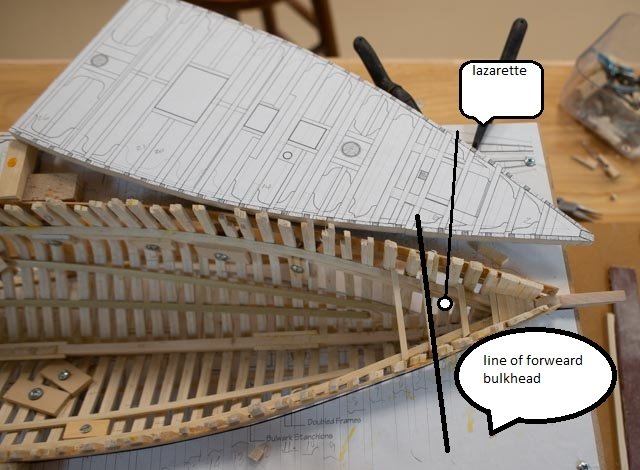
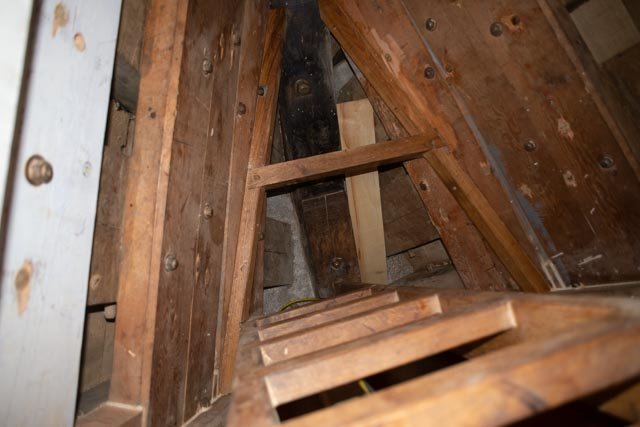
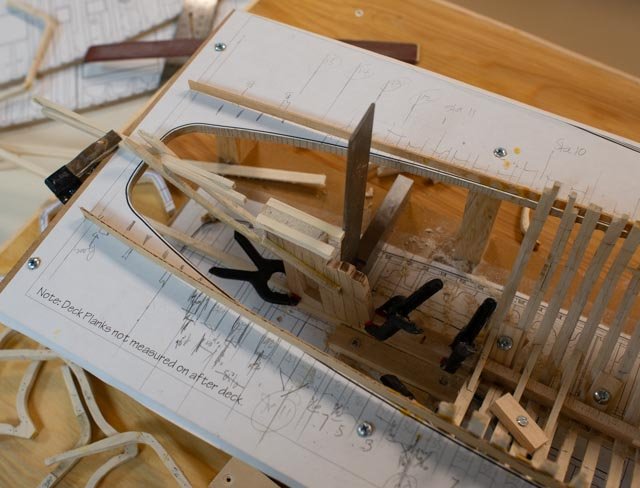
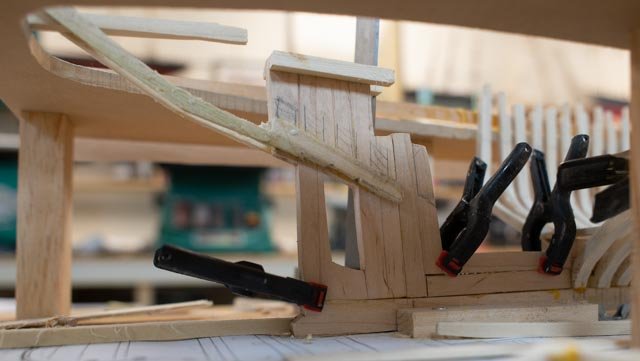
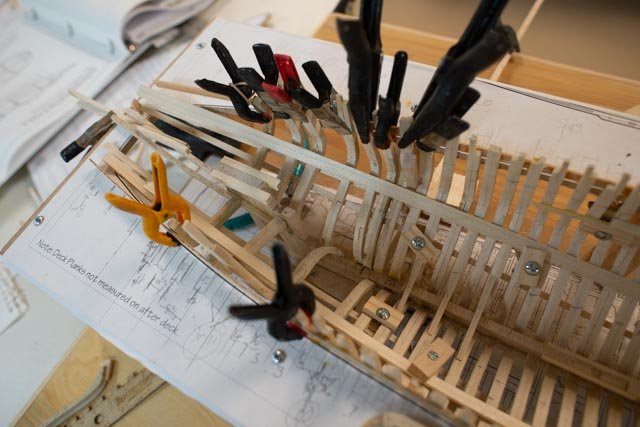
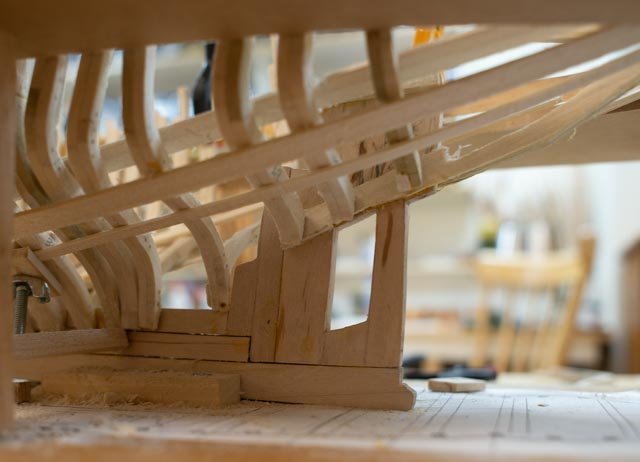
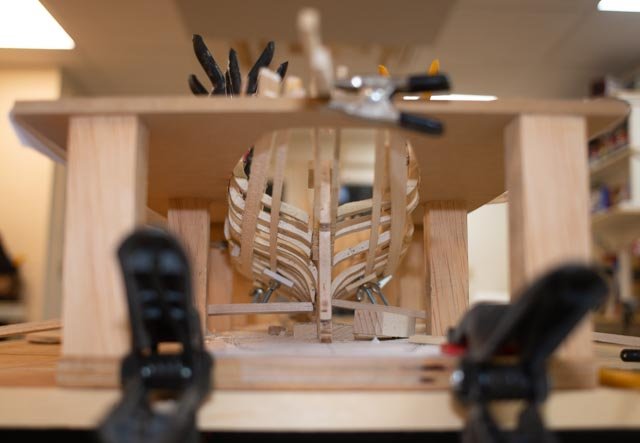
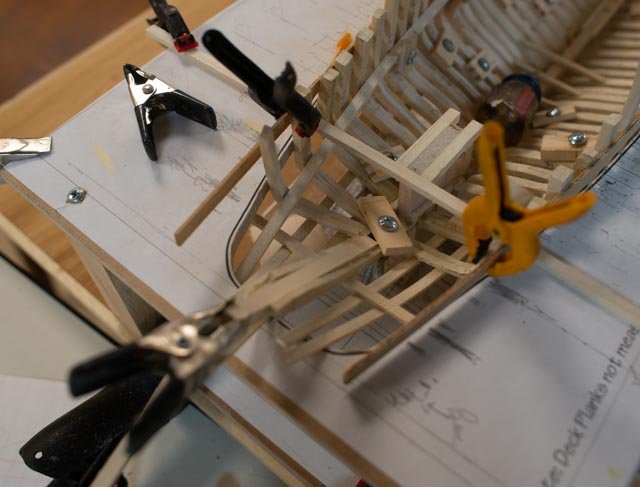
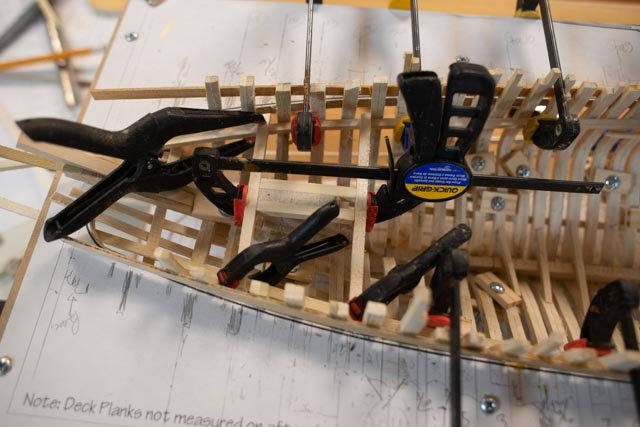

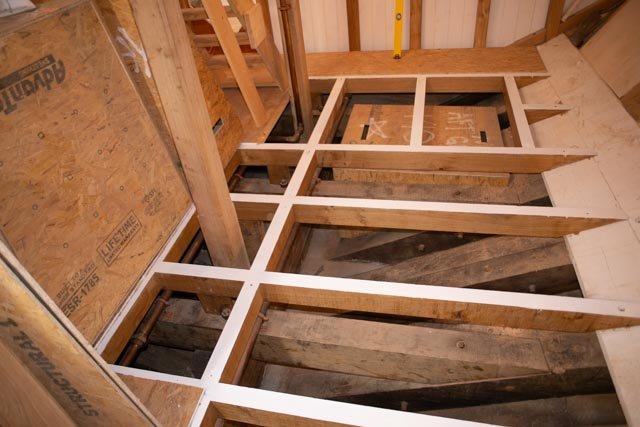
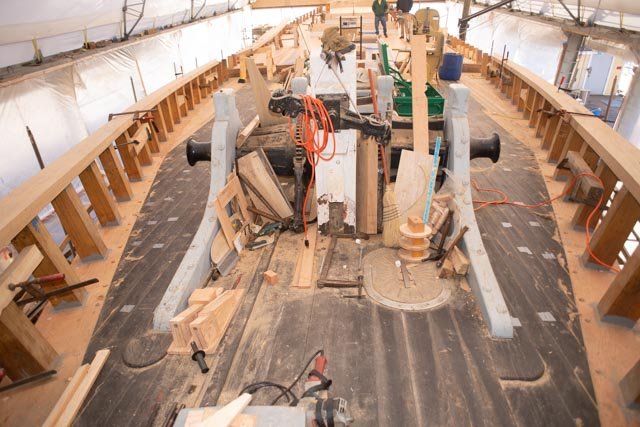
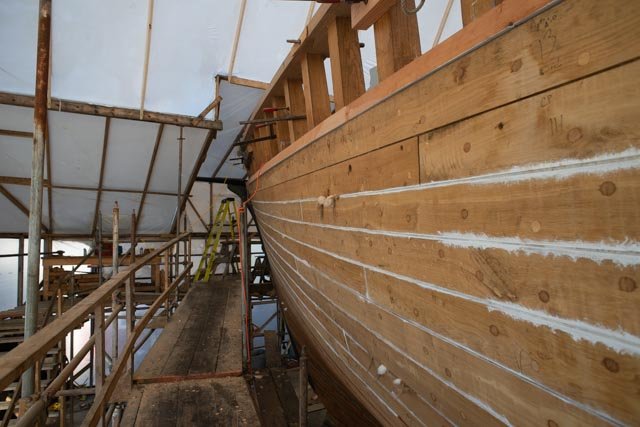
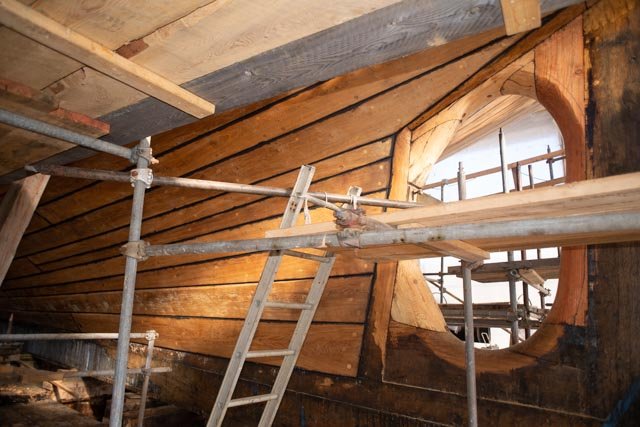
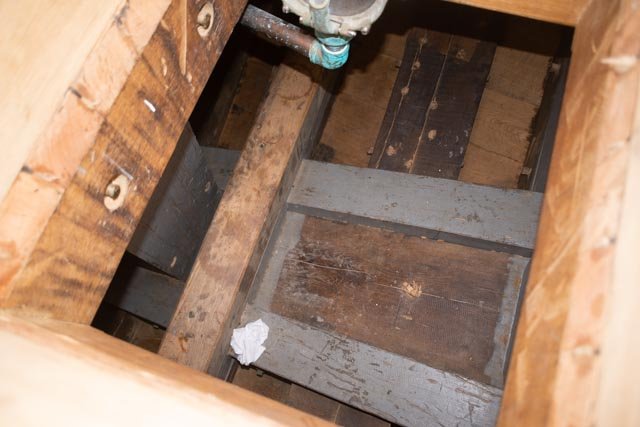
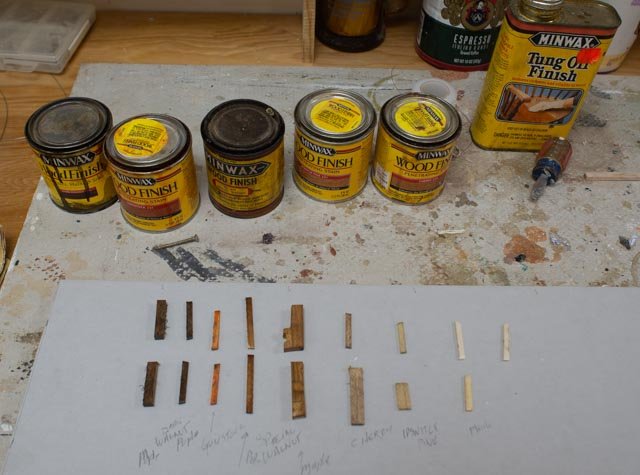
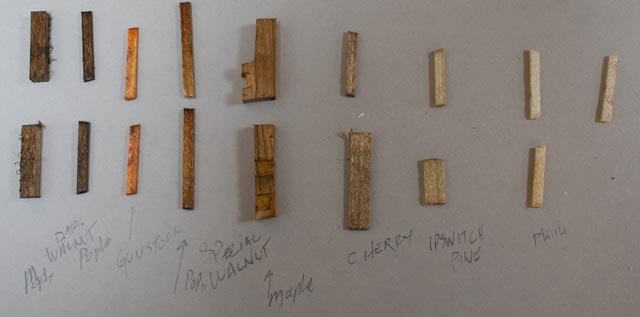
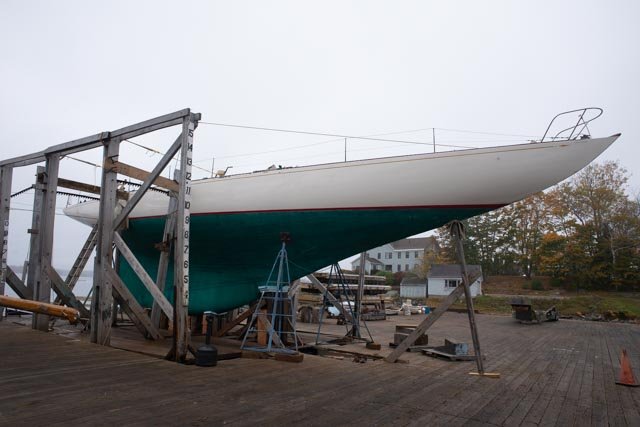

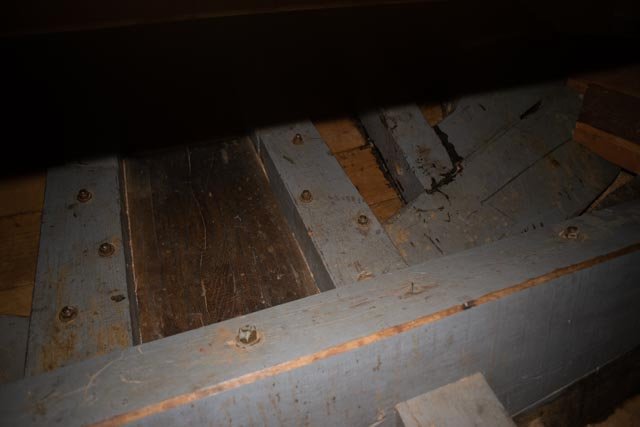
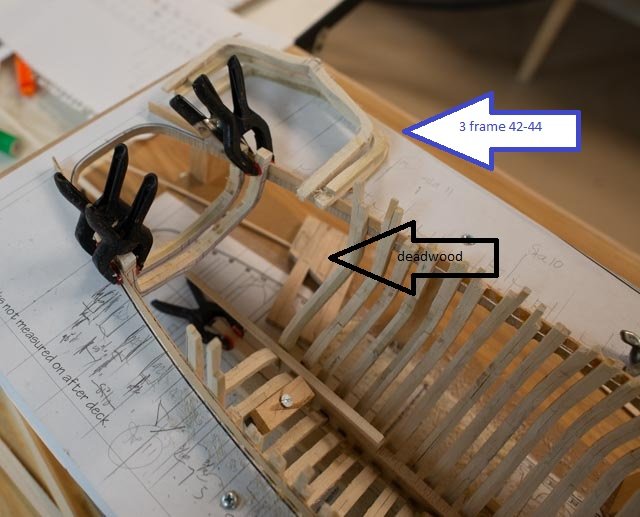
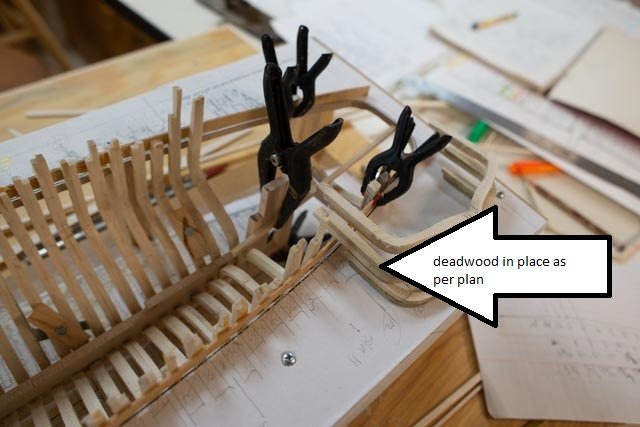
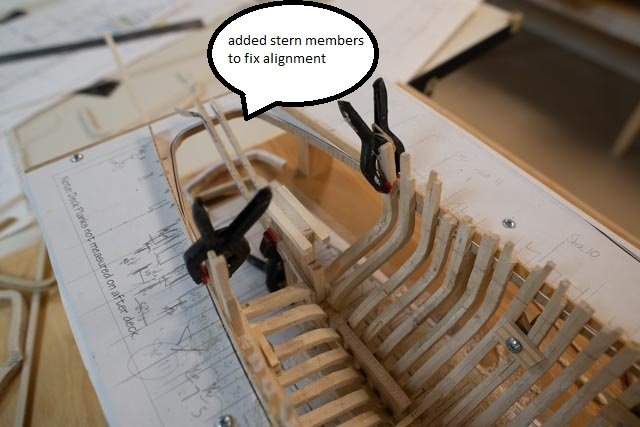
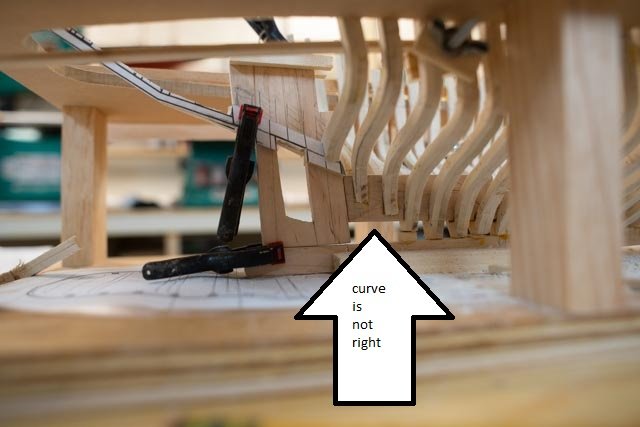
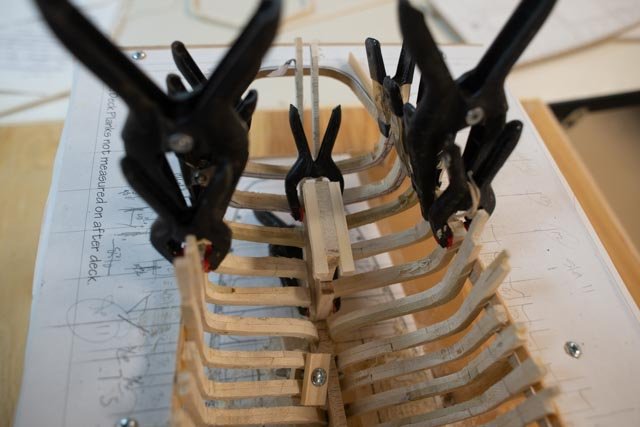
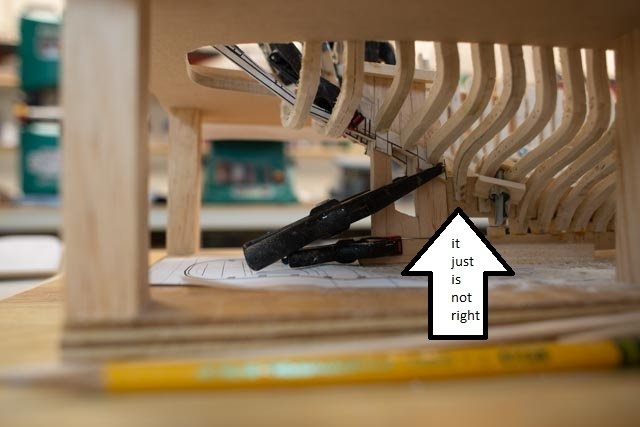
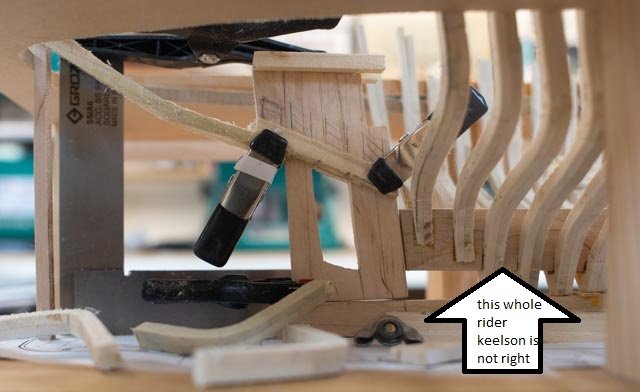
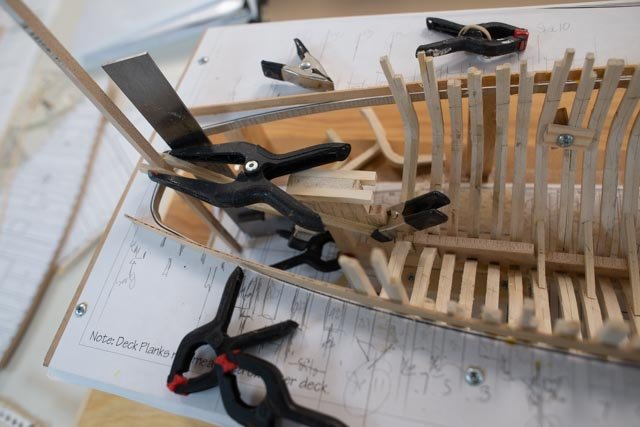
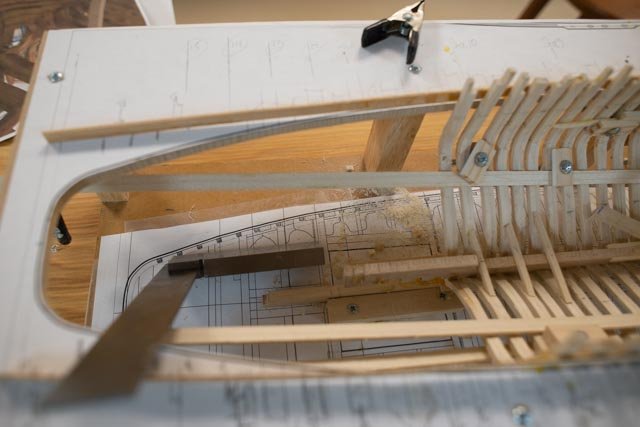

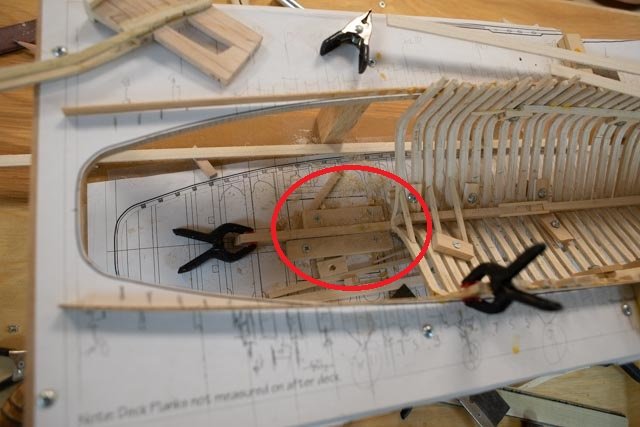
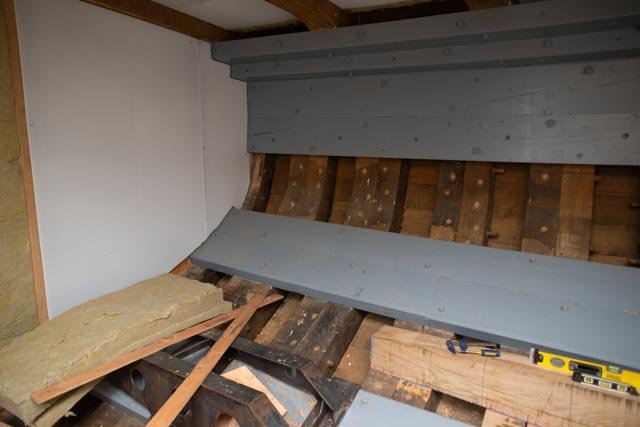
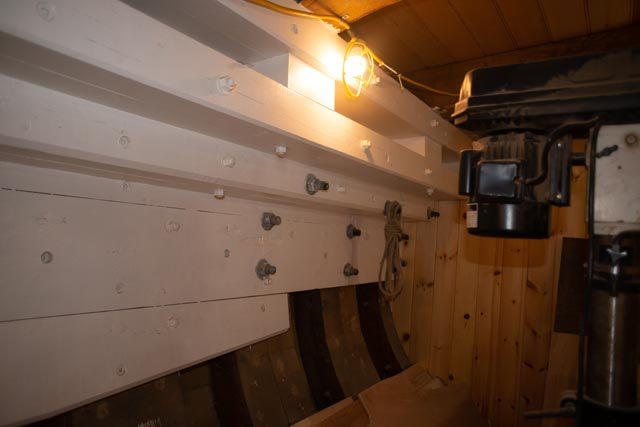
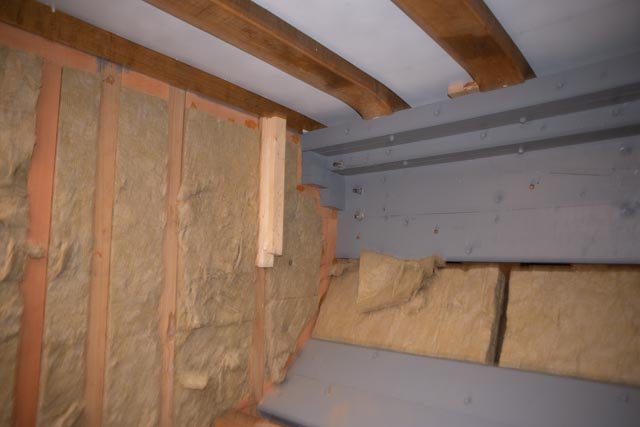
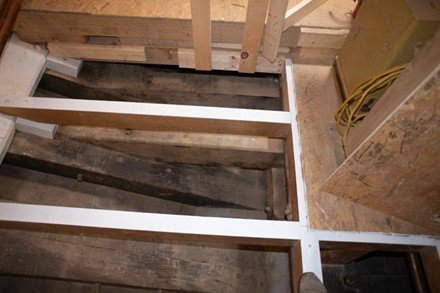
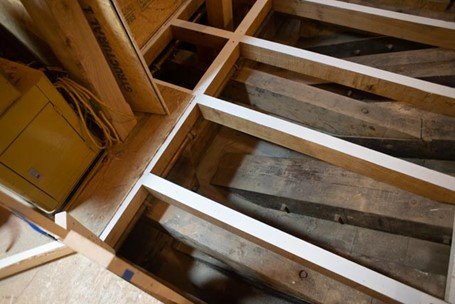

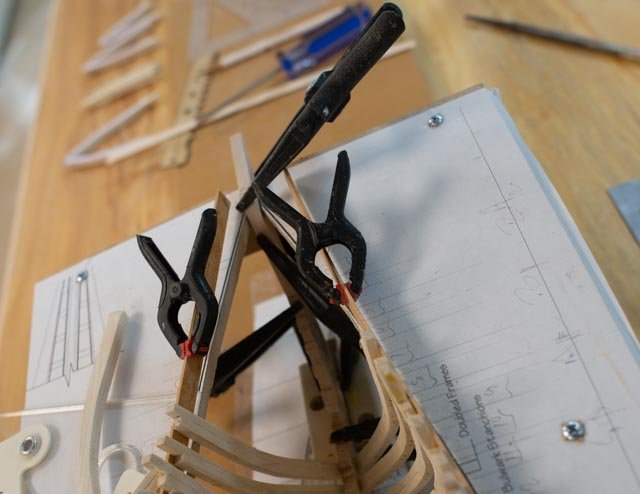
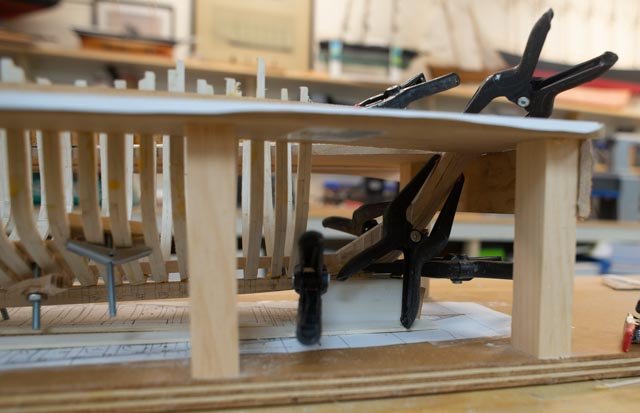
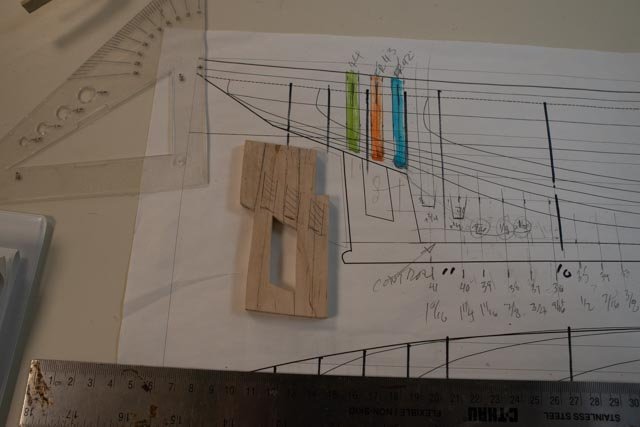
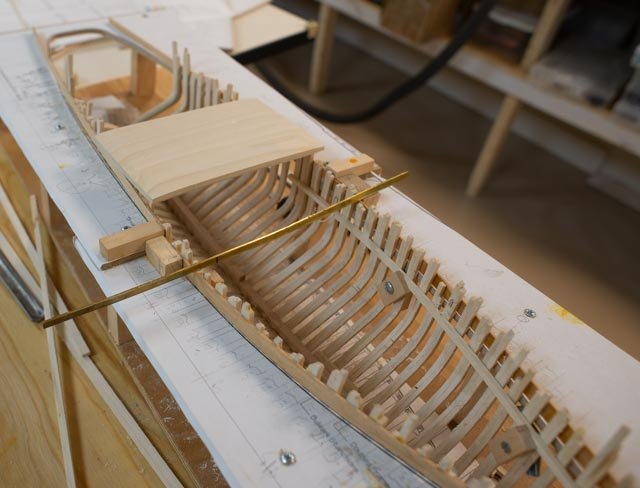
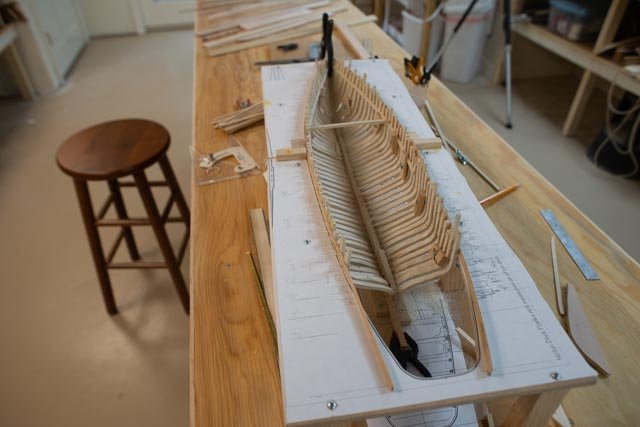
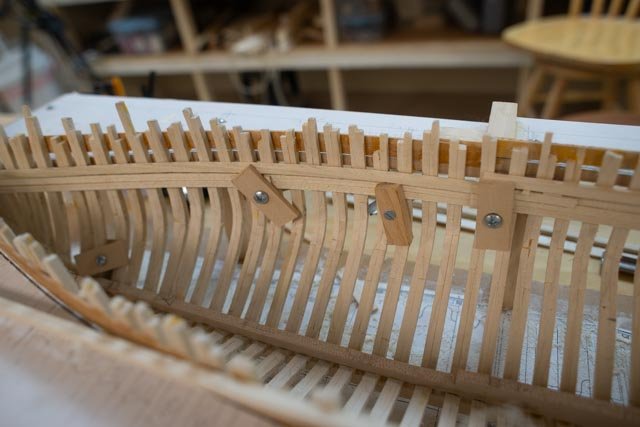
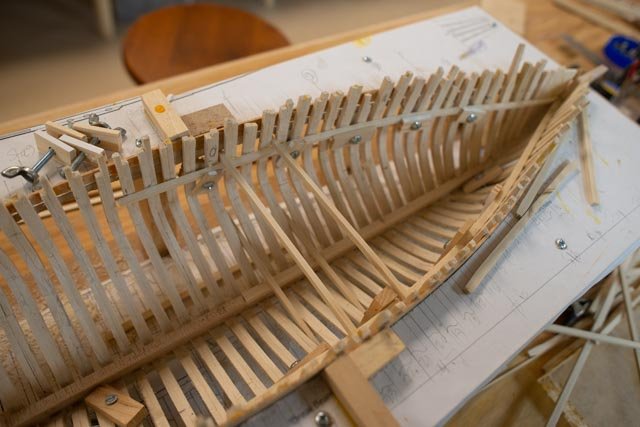
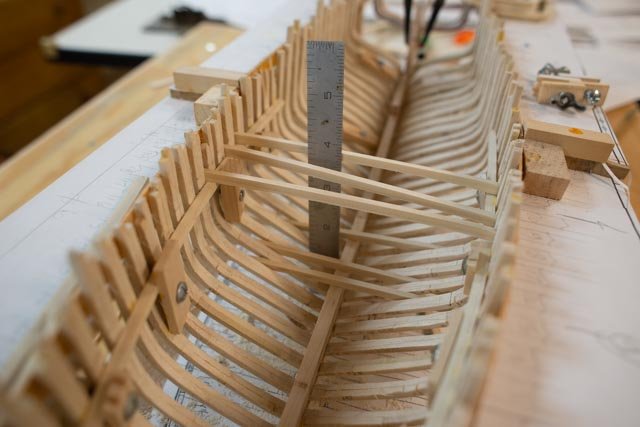
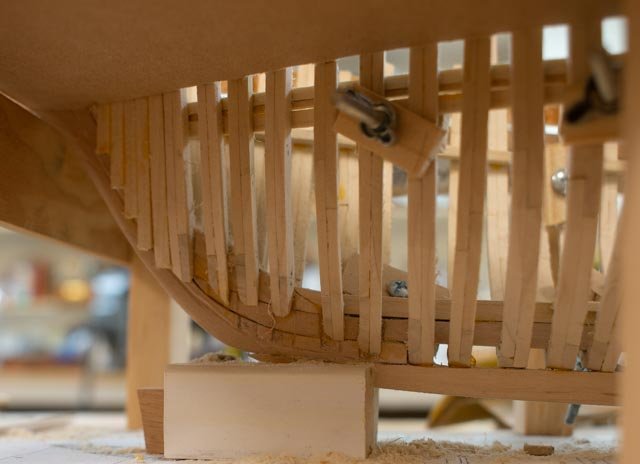
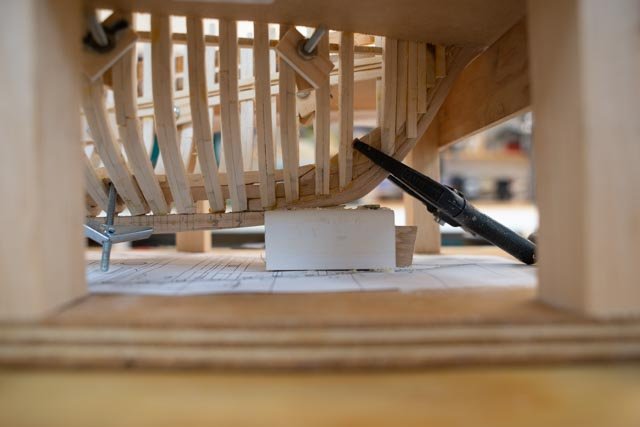
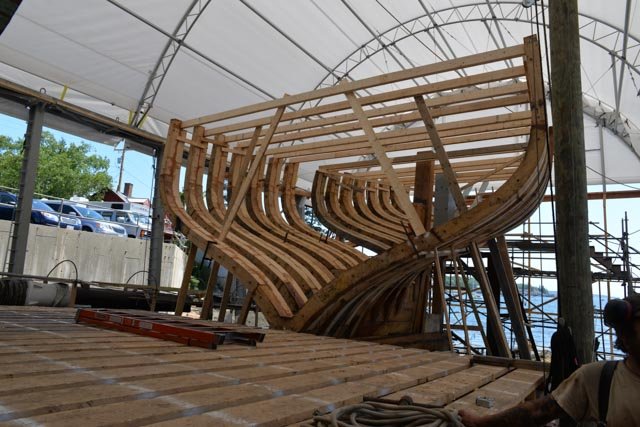
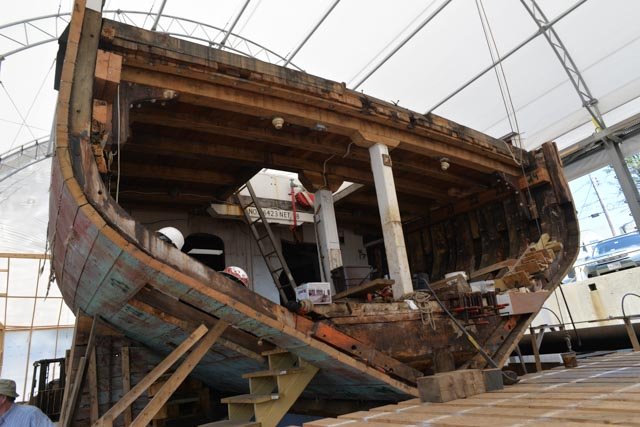

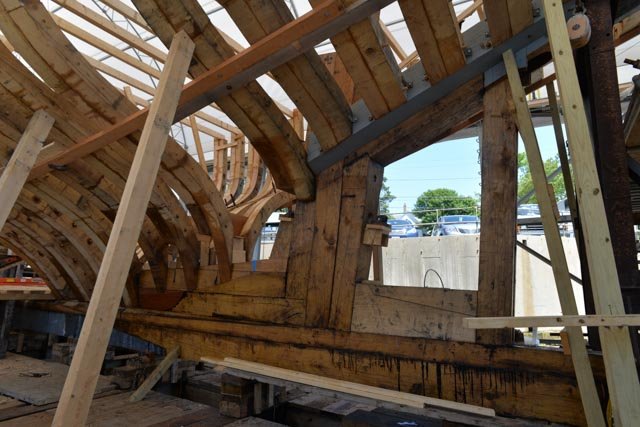
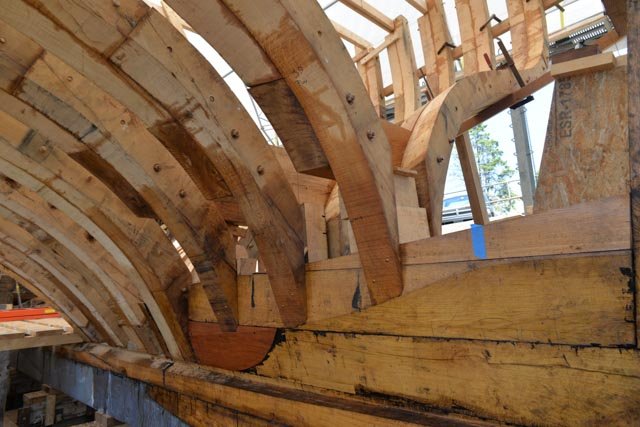
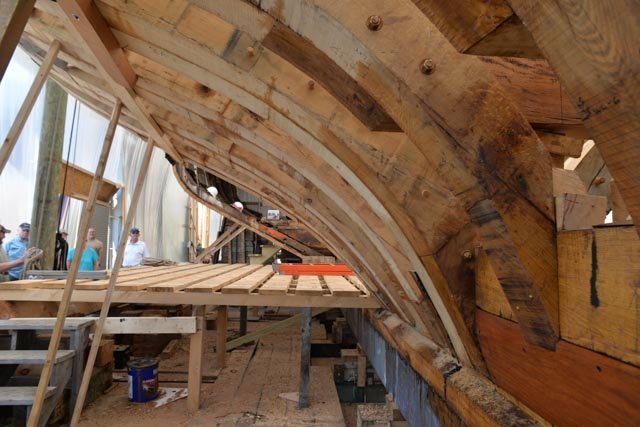
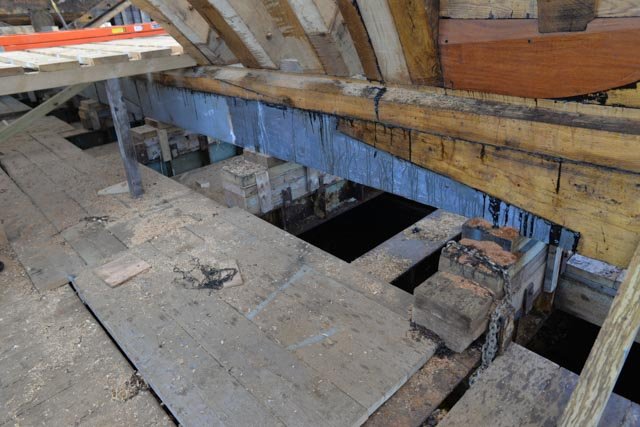
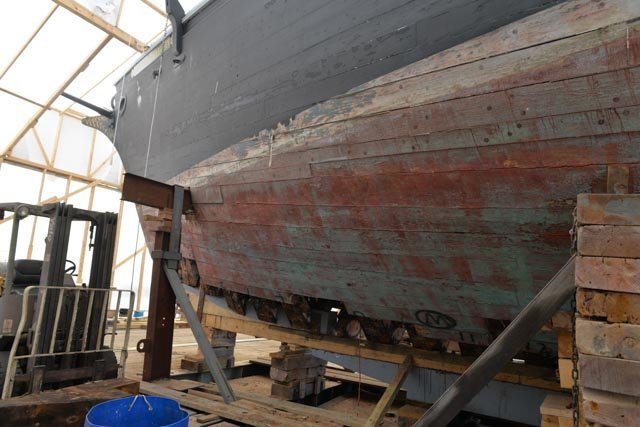
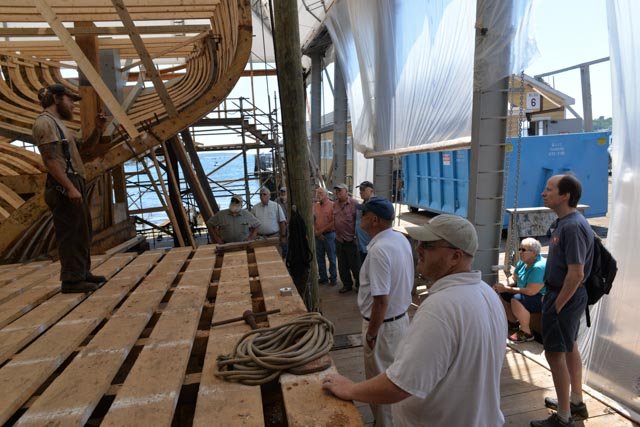

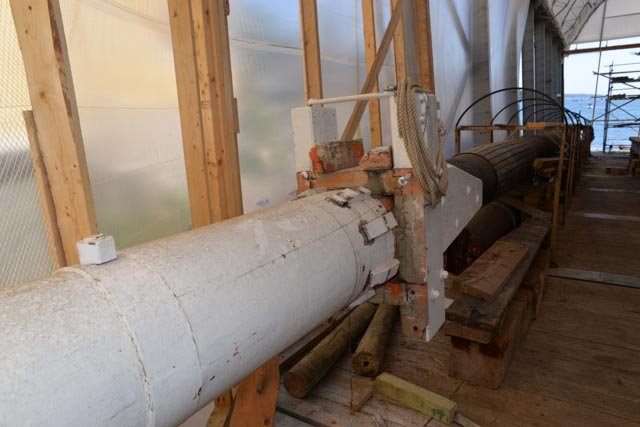
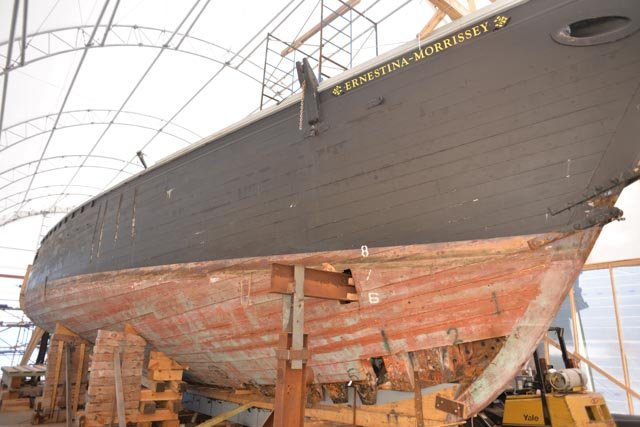

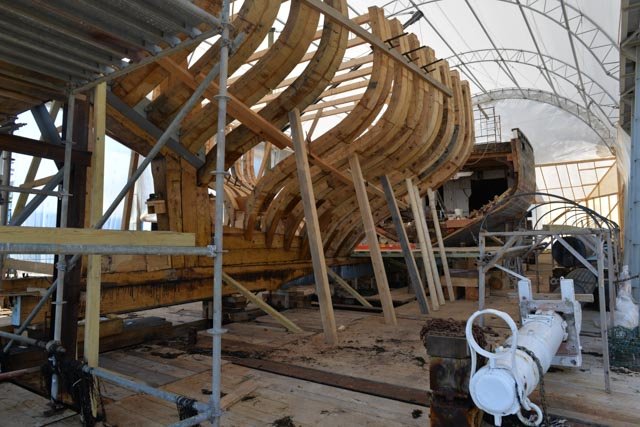

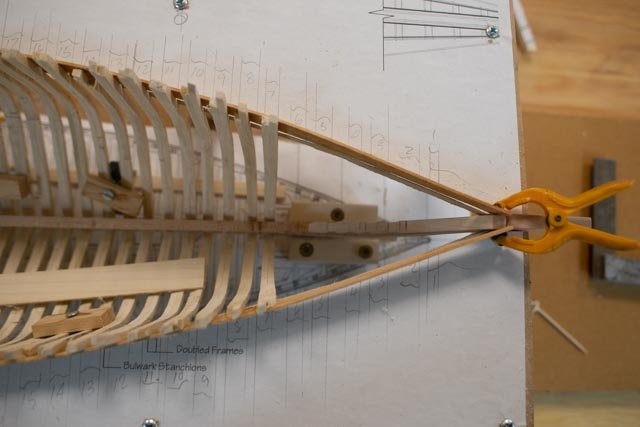
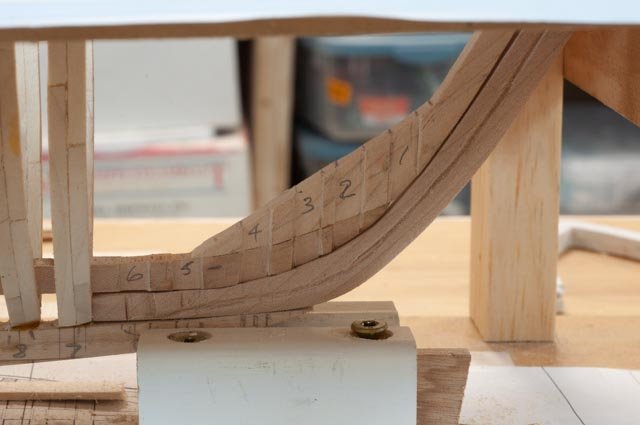
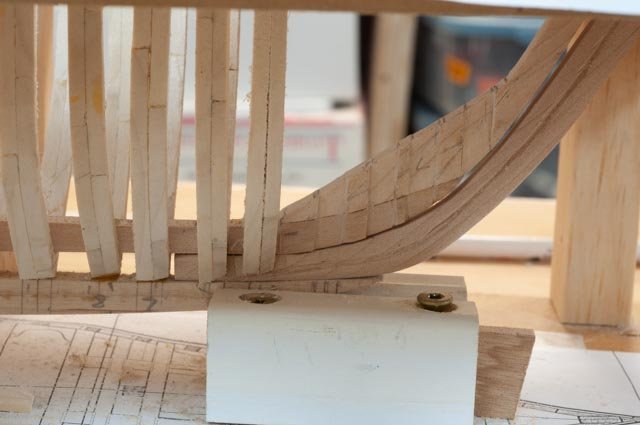
.jpg.0c167e00bc431202ca3378fba75e2b0d.jpg)
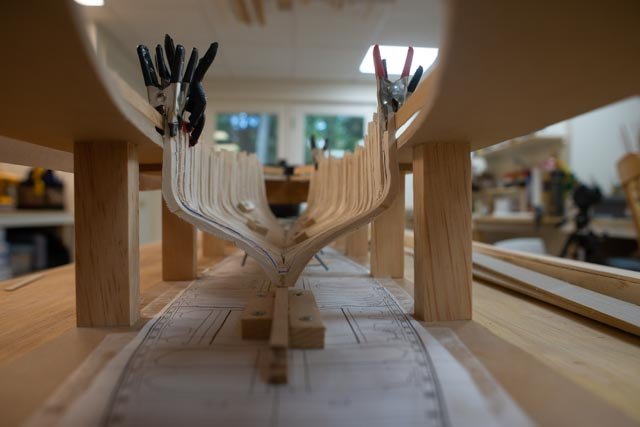
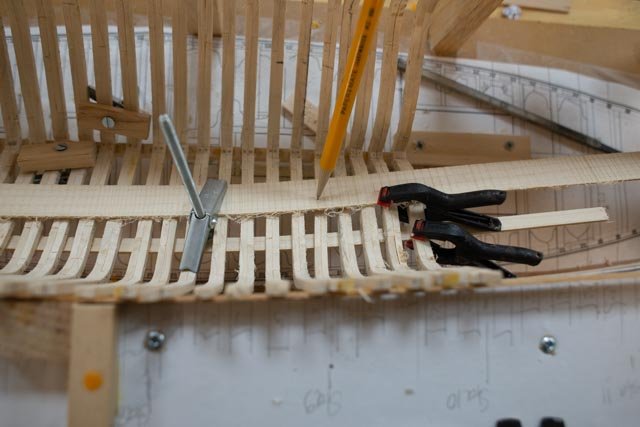
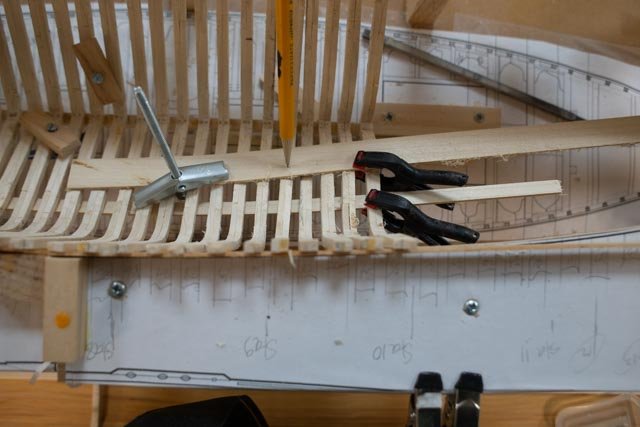
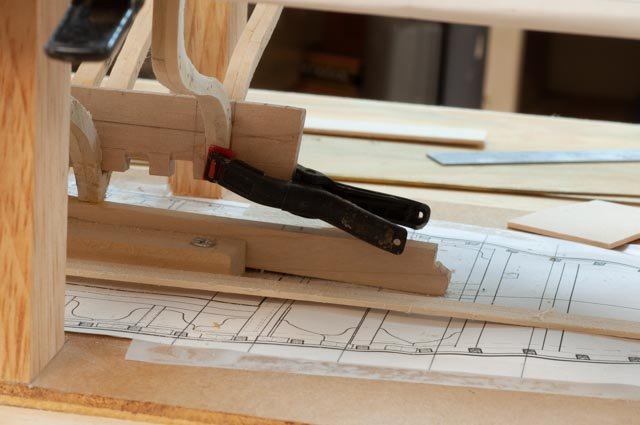
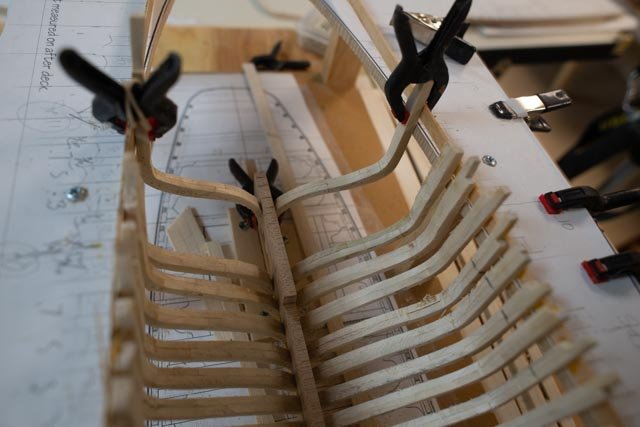
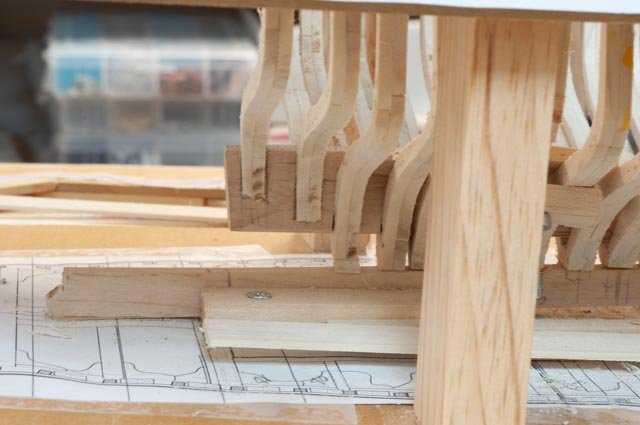
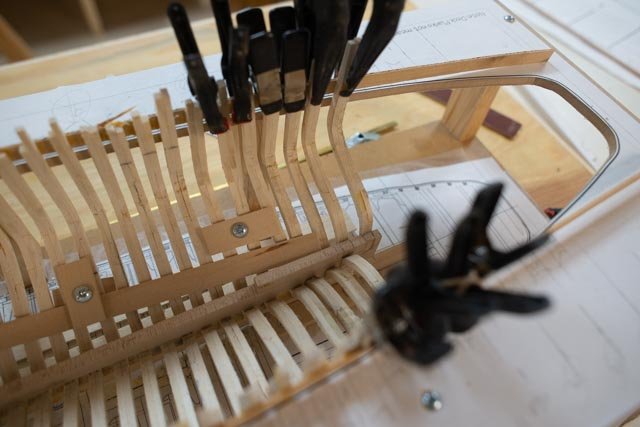
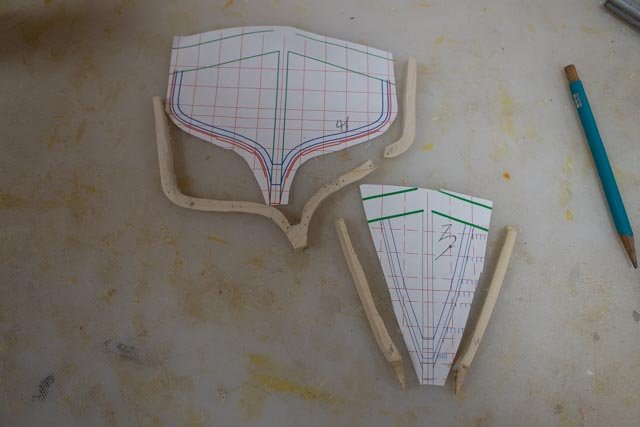
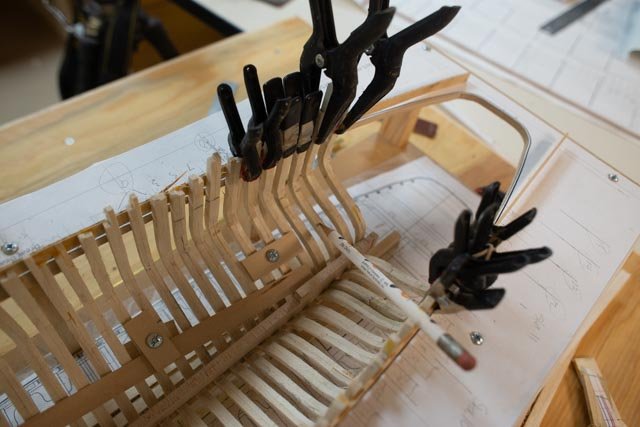
croppedbowframered.thumb.jpg.225dfa61da08a9a9dbd5d880ead54349.jpg)
cropsternred.thumb.jpg.a69221d5ab7c8251cdd7fb97b3f1bbf4.jpg)

